

The 6 Points of Sail: An Illustrated Guide
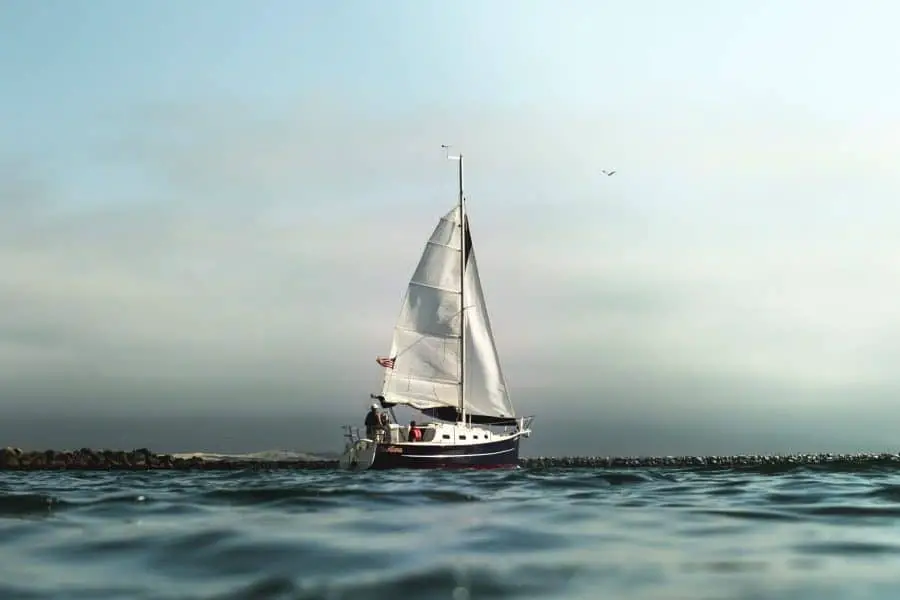
Depending on the direction of the wind and where you’d like to take your sailboat, you’ll need to consider which point of sail to be in. Whether you’re sailing upwind (windward) or sailing downwind (leeward), your sails will either take on the characteristics of an airplane wing or a parachute.
So what are the points of sail on a sailboat? The points of sail include into the wind (in irons), close hauled, close reach, beam reach, broad reach, and running, which go from windward to leeward and are all symmetric from port to starboard.
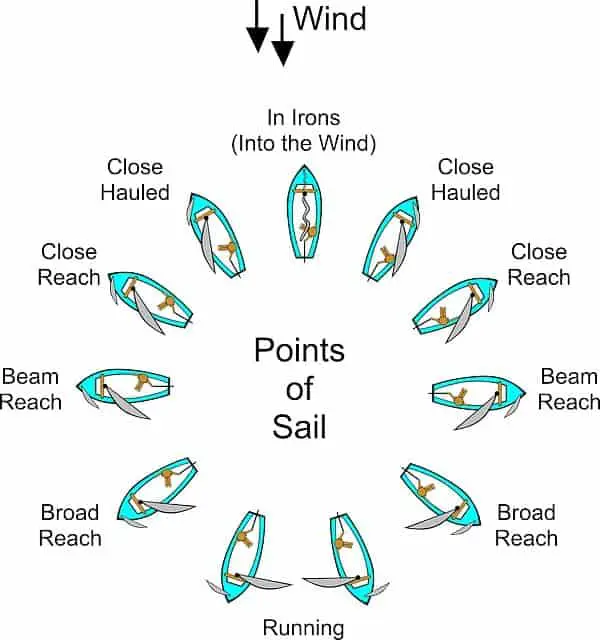
Knowing the points of sail on a sailboat is important in terms of being knowledgeable about how your sailboat generates wind power while also being able to properly communicate with your crew.
It’s also important to understand the difference between upwind sailing and downwind sailing.
There’s a lot of sailing terminology to hash out here as well, so let’s dive into all the different points of sail and learn what they all really mean.
Points of Sail
A point of sail is the direction of a sailboat’s journey while taking into consideration the direction of the true wind as opposed to apparent wind.
The difference between true wind and apparent wind is that true wind is the wind that’s felt by something or someone in one place (like on land) while apparent wind is the wind felt when on the move (like on a sailboat).
The points of sail, when combined, complete a full 360 degrees. Starting from the top (0 degrees) all the way to the bottom (180 degrees), we’ll now explore the different points of sails.
1. Into the Wind (In Irons)
Being into the wind or in irons means your sailboat is going straight into the wind (plus or minus 45 degrees from 0), which will prevent your sailboat from… sailing!
Being into the wind can’t be 100% avoided, and it shouldn’t be, but it’s generally not where you want to be if you plan on moving.
The into the wind point of sail is more often a pivot point for when performing other sailing actions including tacking as well as raising and lowering the mast.
When tacking, your point of sail will change from one side of the sailboat to another while crossing the into the wind point of sail. If you’re not able to cross this point of sail fast enough and get stuck, this is called being “taken aback”.
This is also considered the “no-go zone” or “no sail zone” because, you guessed it, you won’t be going anywhere fast when in this space for too long.
If your sailboat’s in the into the wind point of sail for a long enough time, your sailboat will lose all forward momentum and end up sitting around.
2. Close Hauled
The close hauled point of sail is a tad bit greater than the 45-degree mark on either side of the sailboat.
When at this point of sail, you’ll sail upwind and is often called “beating” as well as “working windward” since your boat is moving toward the wind. Sailing close hauled means you’ll be feeling the wind much more as a captain and crew member!
While sailing close hauled, your sail will be functioning as similar as it can to a wing on an airplane due to it cutting the wind dead on resulting in generating a lot of life.
As a matter of fact, this is when you’ll have the tightest sail trim. The closer you are to the wind (or the “no-go zone”), the more to “point” your sailboat will be.
3. Close Reach
As your sailboat “bears away” (moves away from the wind), it’ll enter the close reach point of sail. This point of sail sits right in between the close hauled and beam reach points of sail on either the port or starboard side of a sailboat. Close reach is a fun and fast point of sail for many sailors!
Close reach is the closest point of sail to the “no-go zone” as any other point of sail, so it’s important to pay attention to the wind and your boat sails.
Since sail trim is so important when it comes to your sailboats speed, it’s important in a close haul to keep your sail tight (similar to a close hauled point of sail) but loose enough so it’s just on the verge of luffing.
4. Beam Reach
When entering a beam reach point of sail, your sailboat will be perpendicular to the wind either on the starboard or port side.
Being in beam reach means you’ll be letting your sails halfway out and you’ll be moving relatively faster than other points of sail. As a matter of fact, it’s known to be the fastest point of sail when on a sailboat!
Not only is beam reach the fastest point of sail on a sailboat, but it’s also the most comfortable due to having more control.
The way in which the wind hits your sails at this point of sail means your boat will be transferring energy more efficiently from the sideways force of the wind to the propelling motion forward.
5. Broad Reach
Moving away from a beam reach and into a broad reach point of sail results in letting your sails out about 2/3 of the way.
At this point of sail, the wind is not coming astern from your sailboat and your sail will act more like a parachute than a wing. Now that you’re sailboat’s heading downwind, you’ll also feel a little less of a windy feel but still should be chugging right along.
Since a sail will be out almost the entire way when in a broad reach point of sail, it’ll start to feel like you’re going downhill when it comes to the wind.
While your sailboat won’t yet be truly going entirely downwind, you’ll be on the verge of entering it.
While not the fastest point of sail, I’m a personal fan of broad reach since we’re going at a decent speed and it feels much calmer (in terms of the wind speed) than more windward points of sail.
When you let your sails out the most they can go and the wind is coming directly behind your sailboat, you’ll sail downwind and you’re definitely on a running point of sail.
This point of sail can truly feel like you’re running downhill since you have the force of the wind directly propelling you and your sailboat forward. As a matter of fact, it acts a lot like a parachute and really feels great!
Also known as a “dead run”, the running point of sail doesn’t require critical attention to be made on the sail trim.
Depending on the strength of the wind speed, this means you can consider putting up a genoa or spinnaker sail to really get your sailboat moving when sailing directly downwind.
If you feel that the wind is fairly constant in terms of direction and intensity, this is a great time to put those massive colorful sails up!
How a Sail Works
When I first learned how to sail, I thought the sail was always acting kind of like a kite and simply floating across the water. Well, it turns out that it’s a little more complicated and interesting than that!
As I mentioned before, the sail can act in two different ways: as a wing and as a parachute.
When in the close hauled, close reach, and partially the beam reach points of sail your sailboat’s sail is acting a lot like a wing .
Based on the magnitude and angle at which the true wind and sailboat are traveling, the combination of the two will produce an apparent wind force.
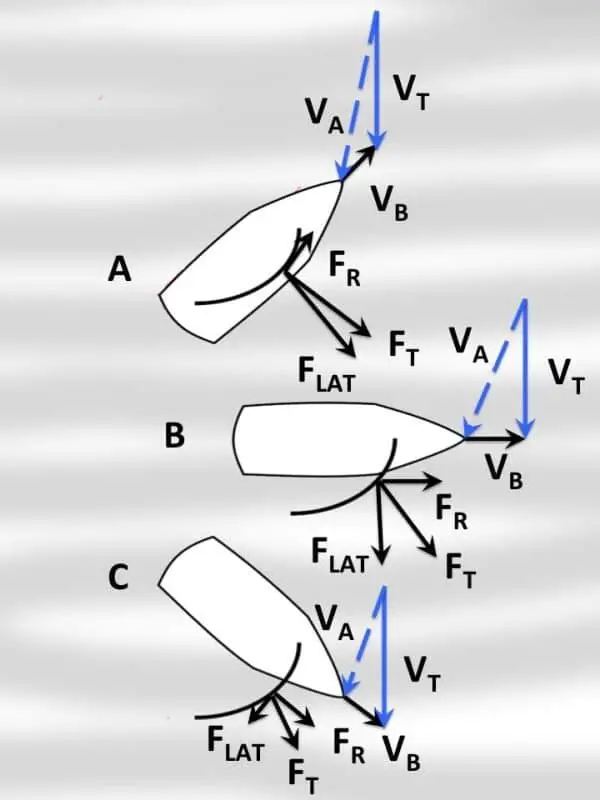
The transfer of energy to produce a forward moving force is mainly due to the sail, keel, and hull .
Essentially, the sail catches the wind’s energy forcing the sailboat to tilt to the side followed by resistance to this tilting from the keel allowing the hull to effectively cut through the water with the remaining force.
When in the broad reach and running points of sail, these forces are still at play resulting in a wing-like action, however, in these points of sail the true wind and sailboat forces are much more aligned.
Essentially, this produces more of a parachute effect as opposed to a wing since the apparent wind force is indistinguishable from the other forces.
Related Questions
What is the best point of sail? The best point of sail is based on personal preference, but the fastest and most comfortable point of sail is beam reach. The combination of the lateral force from the wind onto the sail and the resisting force from the keel produces the strongest forward-moving force on a sailboat.
What is the difference between a jib and genoa sail? Both a jib and genoa sail are sails hoisted at the fore of a sailboat with the genoa being larger in size. The genoa sail oftentimes overlaps the mast due to its size and is mainly used when in a running point of sail.
How do you turn a sailboat? Turning a sailboat occurs when performing a tack or jibe (gybe). Tacking happens when a sailboat is turning into the wind, which requires a traversal through the “no-go zone”. Conversely, jibing happens when traversing through the running point of sail.
Get the very best sailing stuff straight to your inbox
Nomadic sailing.
At Nomadic Sailing, we're all about helping the community learn all there is to know about sailing. From learning how to sail to popular and lesser-known destinations to essential sailing gear and more.
Quick Links
Business address.
1200 Fourth Street #1141 Key West, FL 33040 United States
Copyright © 2024 Nomadic Sailing. All rights reserved. Nomadic Sailing is a participant in the Amazon Services LLC Associates Program, an affiliate advertising program designed to provide a means to earn fees by linking to Amazon.com and affiliated sites.
Points of Sail Explained (with Degrees and Diagram)
When you're new to sailing, you discover a whole new language to describe what's going on with the boat. One of the most fundamental pieces of terminology you'll learn day one in every Learn to Sail course are the points of sail .
Every direction of sailing relative to the wind has a name, and the meaning of that main is a critical piece of understanding you'll need when you're learning to sail. The main points of sail from straight upwind are beating (or "close hauled"), reaching (close, beam, and broad), and running. There is also a no-sail zone straight upwind, though this is not generally viewed as a point of sail since you can't sail there.

On this page:
Upwind sailing: against the wind, no-sail zone: limit to upwind sailing, close-hauled: sailing close to the wind, reaching: fastest point of sail, running: sailing downwind.
The physics of sailing a boat downwind is pretty simple - the wind fills the sails and pushes on them, and the boat is pulled through the water by the forces on the sails.
But how about sailing upwind? The wind is pushing against the boat after all.
While a full explanation is outside the scope here, a boat moves upwind by a combination of forces of the wind on the sails and the keel resisting that force against the water. Wind pushes against the sails with a lifting force and tips the boat, and the keel pushes back against the water and keeps the boat from side-slipping. The combined forces net out in the forward motion of the boat.
As the bow of the boat turns away from the wind, we adjust the sails to keep the forces maximized and the boat moving efficiently.
Apparent Wind is the wind as it feels on the boat, versus true wind , which is the absolute wind speed and direction over the water. Apparent wind includes the true wind and the motion of the boat added together. A bicyclist riding at 10 knots straight into a 5-knot breeze feels 15 knots of apparent wind, but riding downwind they feel only 5 knots. Sailing upwind, the boat is moving into the wind and the apparent wind increases. The opposite happens when you sail downwind.
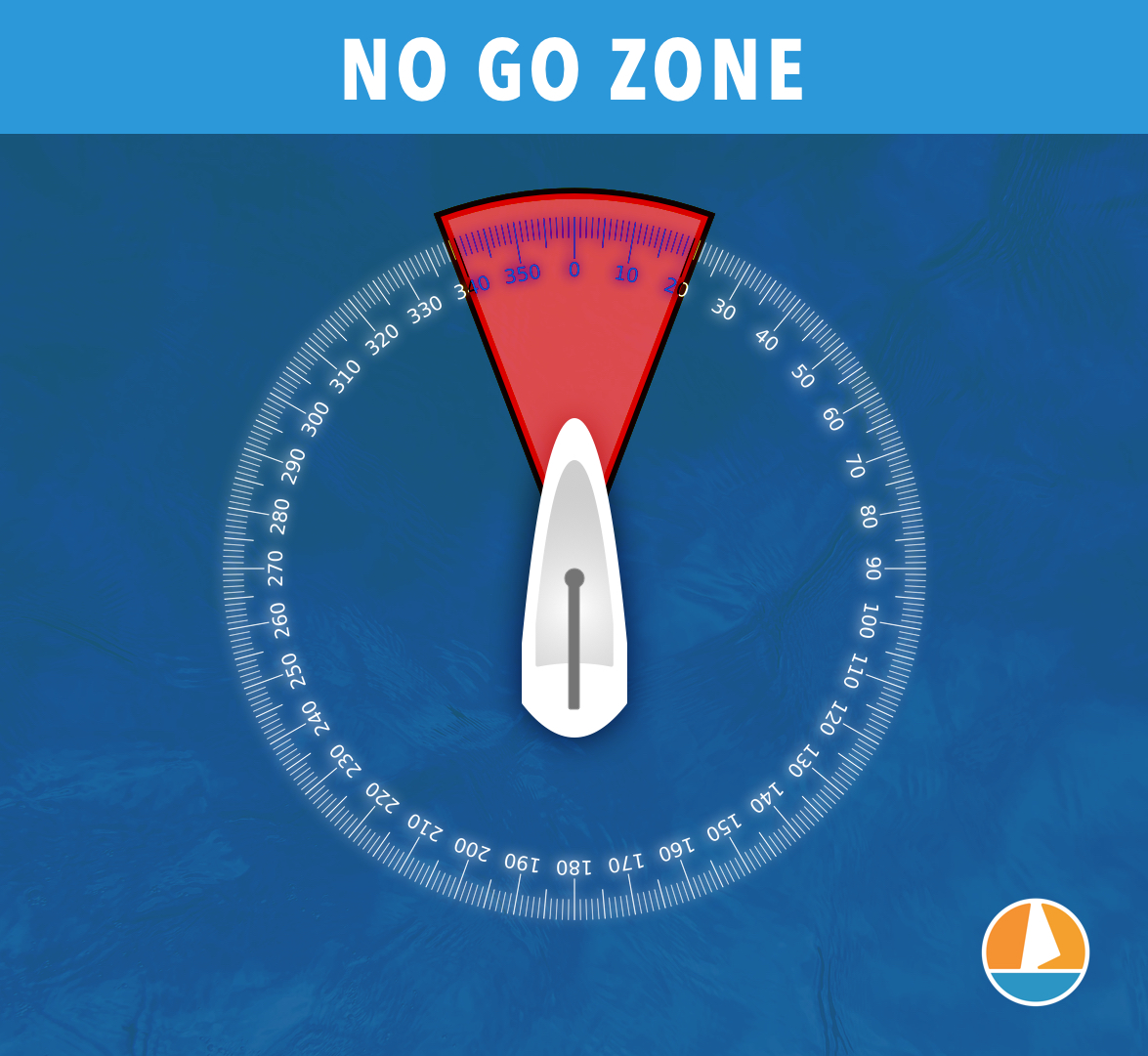
Sailboats can not sail straight upwind. The wind and water work against the sails and keel to propel a boat upwind, but there is a practical limit upwind beyond which a boat can not sail. Any boat trying to sail in the no-sail zone will end up in irons and lose control and drift until the bow falls far enough off the wind for the sails to fill and work again.
The exact size of the no-sail zone varies by the type of the boat and its rig, as well as how skillfully it is trimmed. A high-tech, modern racing boat with a professional crew can sail up to about 30 degrees off the wind, and an old square rigger might struggle to sail 70 degrees off the wind. A typical small boat sailed by amateur sailors will sail about 45 degrees off the wind.
Forty-five degrees off the wind makes for a ninety-degree angle cone upwind where a typical boat can not sail.
Close-hauled, also known as beating, is sailing as close to upwind as the boat can without stalling. For a typical boat, this is about forty-five degrees , though careful observation of the boats you sail on will show some variety in this number.
To sail upwind, sheet sails mostly in and bring the boom to centerline. The boat will heel as it gets on the wind, and this is the point of sail with the most tipping. The apparent wind is also highest close hauled, and it will be windier and cooler with more splashing.
In order to make progress sailing against the wind, a boat must tack back and forth across the no-sail zone. Each tack will sail the boat closer to a point in the upwind direction, but the typical close-hauled course to a point upwind looks like a zig-zag across the wind.
It's a good idea for boat owners to learn the limits of the boat for upwind sailing, and how to maximize "point" into the wind. If you have to sail somewhere upwind - and especially if you want to race - knowing how high you can sail helps you sail more efficiently.
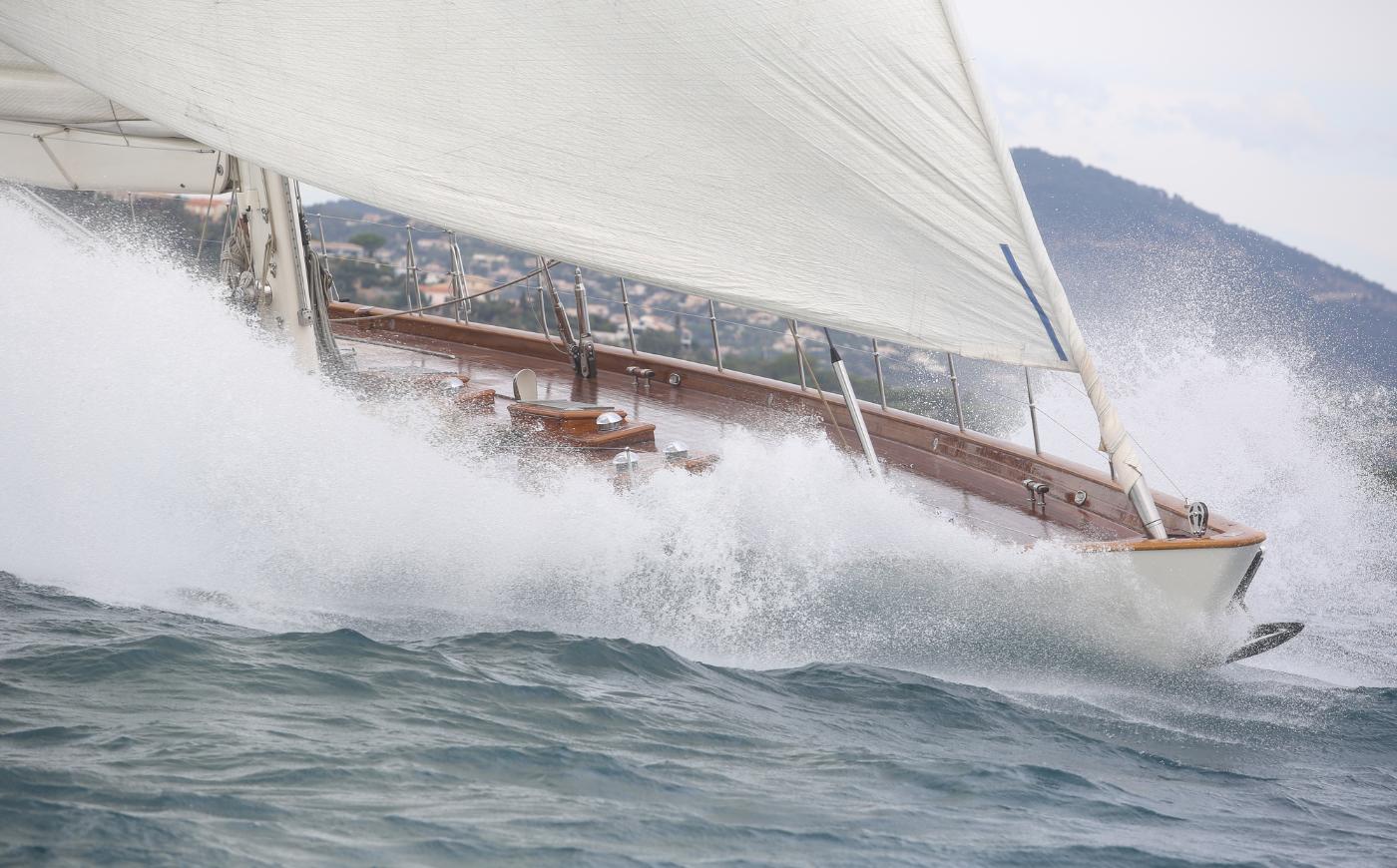
Reaching is the point of sail between close hauled and running - from 50 degrees off the wind through about 135 degrees. But that's a very broad range, so we break reaching angles out a bit more into Close Reach , Beam Reach , and Broad Reach .
Reaching is typically the fastest point of sail, and beam reaching in particular for most boats is very quick. The angle of the wind against the boat and the keel pushing back against the water directs the most force into forward motion and can be an efficient and fun direction to sail.
Unlike beating, when you're reaching it's usually because you're headed straight for a point, and that point is not directly upwind from you. So you don't have to worry about tacking back and forth. You just need to keep the sails trimmed, and the boat pointed where you want to go.
As you bear away from the close hauled onto a reach, the ease the sails a bit more the further you head off the wind. As you speed up, the apparent wind appears to increase, but as the wind moves back, it drops more.
Close Reach: Sailing Close to the Wind
The close reach is the point of sail between close hauled (about 45 degrees) and beam reaching at 90 degrees off the wind. If you're sailing hard upwind on a beat, and you ease the sails and point the boat a bit off the wind, you are close reaching.
The wind is still forward of the boat, so you're making upwind progress on a close reach. The boat will sail faster through the water and heel a little less as you fall off the wind, but you will make less progress directly upwind as you sail further.
Beam Reach: Easiest Point of Sail
When the wind is ninety degrees off the boat , or perpendicular to the beam, you're on a beam reach. For most boats, this is the fastest point of sail since the wind hits the boat at a right angle and we can trim the sails for maximum forward motion.
To trim on a beam reach, ease each sail until it flutters a little, then tighten it in to stop the flutter. While there may be additional controls on your boat to adjust for more fine trim and better performance, for a beginning sailor, these gross sail adjustments will get you on a fast, easy reach.
There is still some heel on a beam reach, but it's much more comfortable than sailing upwind and the boat will tilt a lot less. Big breezes can still add some heel during puffs, but the boat will also dig in and sail faster when that happens!
Broad Reach: Leaving Upwind
Past beam reaching, from 90 degrees until about 135 degrees, you're sailing on a broad reach. This is also a fast point of sail, and the sails should be easy to stay full with telltales streaming. Genoa cars should also move forward, and a little outhaul ease may give you a nice little boost.
You're no longer sailing upwind, but the boat is still getting power from the sails-against-keel action. Your regular upwind sails will still draw very well and keep you powered up, though in light air some sailors will deploy special sails for better performance to capture the downwind components of wind they're in.
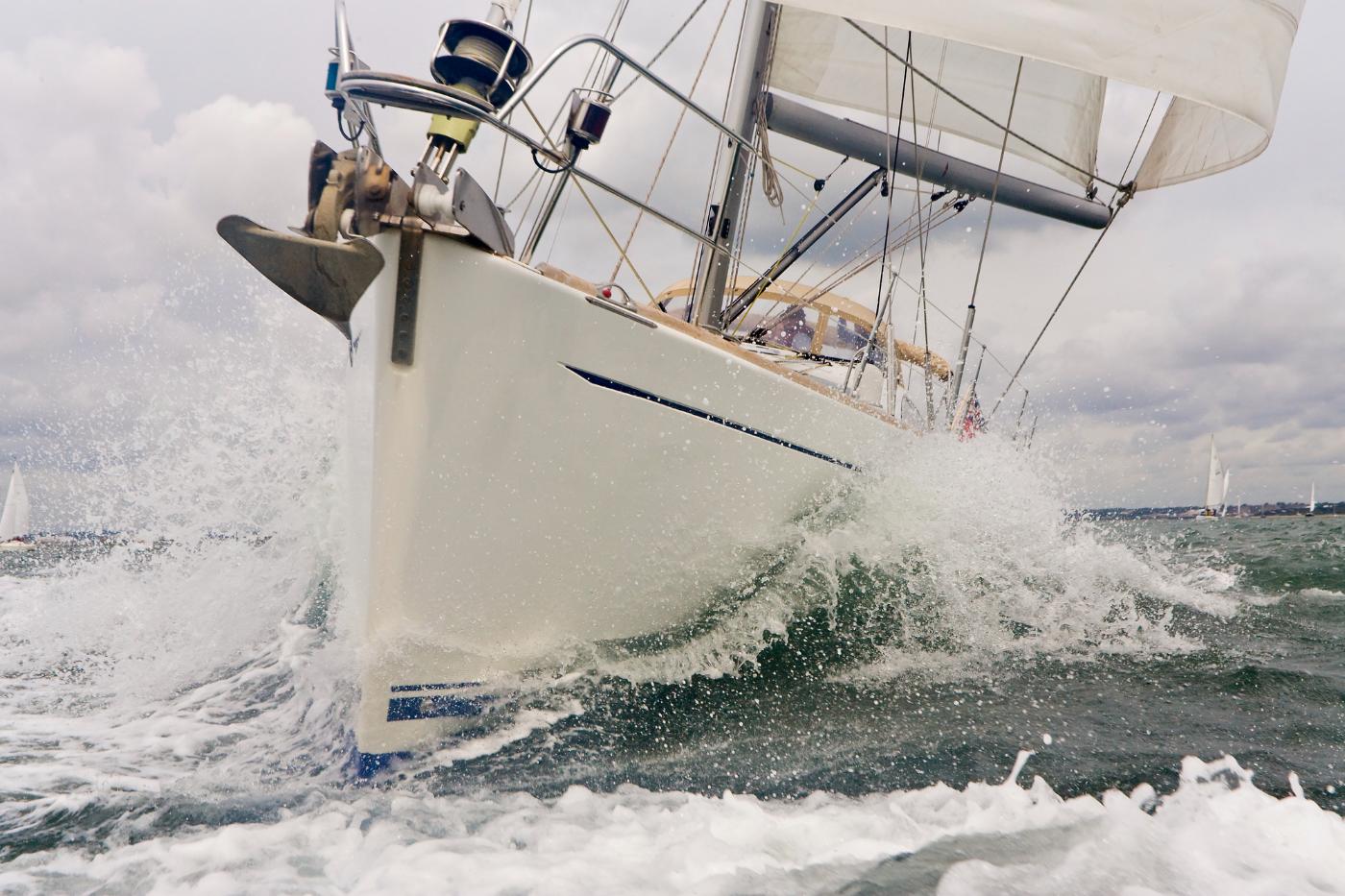
Running off the wind is downwind sailing, and for most boats runs about 135 degrees off the wind to 180 degrees, or Dead Down Wind (or DDW ). Sailing with a jib and main combination gets very slow, and you may need to take some extra steps like holding out the jib with a pole to keep it full, or sailing wing-on-wing , with the main on one side of the boat and the jib on the other like a set of bird wings.
The alternative is to fly a spinnaker, the best way to get more speed off the wind. These large, light sails fill like parachutes and give a lot more driving force than a heavy jib or genoa, which may get blanketed behind the main or have a hard time staying full in the lighter apparent wind.
The exact angle to switch to downwind sails varies by the boat, sail type, and conditions. A symmetrical spinnaker typically isn't flown until deeper sailing angles, but a boat with an asymmetrical spinnaker on a bow sprit may sail best with that spinnaker starting on a broad reach.
When running deep, be careful of accidental jibes. Sailing DDW can be the straightest line to a point, but a sudden shift in the wind can move the wind across your stern, and suddenly your main sail is on the wrong side of the boat and may slam over in an unplanned jibe. This can damage the boat and cause serious injuries.
It's often better for less experienced sailors to sail a little higher than DDW until they know how to spot shifts. Or you can rig a preventer to hold the boom in place to stop the jibe.
Leave a comment
Own your first boat within a year on any budget.
A sailboat doesn't have to be expensive if you know what you're doing. If you want to learn how to make your sailing dream reality within a year, leave your email and I'll send you free updates . I don't like spam - I will only send helpful content.
Ready to Own Your First Boat?
Just tell us the best email address to send your tips to:

- Find A School
- Certifications
- North U Sail Trim
- Inside Sailing with Peter Isler
- Docking Made Easy
- Study Quizzes
- Bite-sized Lessons
- Fun Quizzes
- Sailing Challenge

Where Are We Going: Understanding Points of Sail
By: Zeke Quezada, ASA Learn To Sail , Sailing Tips
The direction of the wind dictates the direction a sailboat can sail. Understanding the points of sail is vital to understanding how sailors orient themselves relative to the wind. The Points of Sail describe the range of courses a sailboat can and cannot travel.
Understanding the Points of Sail
It is physically impossible for a boat to sail directly into the wind but how do you describe that? This “no-sail” zone is approximately a 90-degree zone dead into the direction of the wind. While this zone varies in size depending on the boat and the wind speed it is a universal fact of sailing that a sailboat cannot sail directly into the wind. This can be described as being “in irons.”
That leaves a sailor with 270 degrees of options to move the boat with the aid of the wind. At either edge of the no-sail zone are the two close-hauled courses a sailboat may travel. On these courses, the sails are hauled as close to the boat’s centerline as possible.
As the boat’s course turns away from the wind it is described as reaching. Reaching is the process by which the wind is coming across the boat. Reaching can be divided into three different courses, Beam Reaching , where the wind comes across the boat at a 90-degree angle, Close Reaching as the course gets closer to close hauled and Broad Reaching where the course is further downwind beyond the 90-degree mark.
If the boat is sailing directly downwind the course is said to be running or simply downwind .
Each of these points of sail has its own corresponding sail trim and technique for steering.

Learning the points of sail, and how the sails look and the boat feels on each one, is fundamental to becoming a competent sailor.
Do you want to learn more about the Points of Sail? Take a look at the Sailing Challenge App . The Points of Sail module is a great tool to mastering your knowledge of the subject. The Sailing Challenge app is a cutting-edge gaming app designed as a fun learning aid to help illustrate the principles of sailing in a rich interactive and entertaining format. Available on Windows | Mac | iPads | iPhones .

Learning to Sail
- ASA 101: What You’ll Learn ASA 101 is your introduction to Basic Keelboat Sailboat and is your key to a lifetime of sailing.
- How To Sail Sailing a boat is part art and part skill but few activities offer such a variety of pleasures as sailing. Something special occurs when you cast off the lines and leave your cares at the dock.
- 7 Tips For The Beginning Sailor There are the obvious things you need when you go sailing, sunscreen, a hat, a windbreaker, non-skid shoes, and wind. However, what do you really need to be ready to head out on the water?
- How To Learn To Sail You won’t have to buy a boat or learn a new language or buy a new wardrobe to get a taste for sailing. You can dictate how much you want to experience.
- Learning To Sail Is Just The Beginning Sailing means different things to different people. At ASA we understand that learning to sail is just the beginning of a relationship with a lifestyle that is infectious. Where will sailing take you? We have a few ideas but how you view sailing is the most important.
- What Is Your Role on a Boat? What type of sailor are you and what role do you take on the boat? Your ASA sailing education will prepare you to be a skipper on a sailing vessel and with that comes the responsibility of keeping your crew safe and ensuring the safety of the vessel you are sailing.
Related Posts:

- Learn To Sail
- Mobile Apps
- Online Courses
- Upcoming Courses
- Sailor Resources
- ASA Log Book
- Bite Sized Lessons
- Knots Made Easy
- Catamaran Challenge
- Sailing Vacations
- Sailing Cruises
- Charter Resources
- International Proficiency Certificate
- Find A Charter
- All Articles
- Sailing Tips
- Sailing Terms
- Destinations
- Environmental
- Initiatives
- Instructor Resources
- Become An Instructor
- Become An ASA School
- Member / Instructor Login
- Affiliate Login

Understanding and Using the Points of Sail: A Comprehensive Guide
- No Comments
Welcome to the world of sailing, a dynamic environment where wind and water combine, presenting both challenges and rewards. One of the critical aspects of sailing is understanding the ‘points of sail.’ But what exactly are these points, and why are they so vital for effective navigation?
In sailing terminology, ‘points of sail’ refer to the boat’s course in relation to the direction of the wind. They are the various angles between your sailboat’s heading and the wind direction. These angles play a significant role in determining your sailboat’s speed, stability, and ability to maneuver.
Understanding the points of sail is essential for any sailor. By having a solid grasp of these points, you can better control your sailboat and adjust to varying wind conditions, making your sailing journey safer and more enjoyable. It can also enhance your strategic decision-making skills, especially in racing scenarios where choosing the most efficient course can mean the difference between winning and losing.
In this article, we’ll delve into the different points of sail and provide practical tips on how to navigate each one effectively. So whether you’re a seasoned sailor or a beginner still getting your sea legs, this guide aims to deepen your understanding of this fundamental sailing concept and enhance your skills on the water. Let’s set sail!
Understanding the Wind
Before delving into the specifics of the points of sail, it’s essential to comprehend the fundamental concept that makes sailing possible: the wind. The wind is the driving force that propels a sailboat, and understanding its direction is crucial in navigating your boat efficiently and safely.
Wind Direction
Wind direction is traditionally described as the direction from which the wind originates. For example, a north wind blows from the north towards the south. This concept is vital because it dictates how we set our sails and which course to plot.
When sailing, wind direction can be determined using a variety of methods. Some of the most common include observing the flag on your boat or a nearby mast, feeling the wind on your face, or using a wind vane, an instrument specifically designed to show the direction from which the wind is blowing.

In addition to understanding where the wind is coming from, it’s also important to comprehend that wind is not static. It can shift direction and vary in intensity, often influenced by factors such as weather patterns, geographical features, and atmospheric pressure systems. This variability is known as ‘wind shifts’ and ‘gusts,’ and understanding these can give you an edge when plotting your course or adjusting your sails.
The Importance of Wind Awareness in Sailing
Being aware of the wind direction and its variations is critical in sailing for several reasons. Firstly, it determines the angle at which you’ll set your course and how you’ll trim your sails, directly impacting your boat’s speed and stability. By accurately assessing the wind direction, you can choose the most efficient point of sail and maximize your boat’s performance.
Secondly, wind awareness is key to safety. Sudden shifts in wind direction or unexpected gusts can catch sailors off guard, potentially leading to dangerous situations. By staying alert to the wind conditions, you can anticipate changes and adjust accordingly, keeping your boat under control and your crew safe.
Finally, understanding the wind is crucial in racing scenarios. Skilled racers are always aware of the wind direction and shifts, using this knowledge to plot the most efficient course and gain a competitive edge.
In the next section, we will delve deeper into the points of sail and how each is influenced by the direction of the wind. As you will see, a keen understanding of the wind is the foundation upon which all successful sailing is built.
The Points of Sail
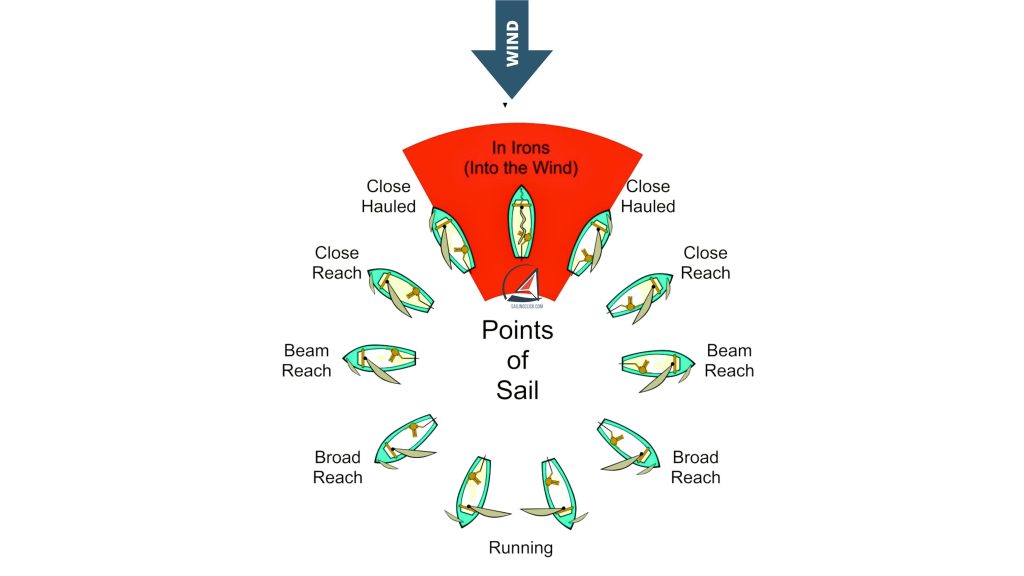
Once you understand the direction of the wind and its vital role in sailing, you can explore the points of sail. These points describe the boat’s angle relative to the wind and influence how we set our sails and steer our course. Here’s a detailed explanation of each point of sail:
- In Irons (Into the Wind): This point refers to the position where a sailboat is facing directly into the wind. It’s the only ‘point’ where sails cannot generate power, as the wind is hitting the sails head-on, causing them to flap or “luff.” It’s essential to avoid this position, especially in situations where maneuverability is necessary, like when avoiding obstacles or other boats.
- Close-Hauled (or Beating): When a boat is close-hauled, it is as close to the wind as it can get while maintaining forward motion. This is usually at an angle of about 45 degrees to the wind. It’s a challenging point of sail as it requires careful balance between steering and sail trim to keep the sails from luffing.
- Close Reach: A close reach is the point of sail when the boat is slightly further off the wind than when close-hauled. Here, the sails can be let out a bit more, and the boat usually achieves higher speeds. This point of sail is often comfortable and relatively fast, making it a preferred point for many sailors.
- Beam Reach : A beam reach is when the wind is coming directly across the boat, at a right angle to the boat’s course. This point is often the fastest and most stable, making it a favorite among many sailors. The sails are halfway out, and the boat is powered across the wind.
- Broad Reach : A broad reach occurs when the boat sails further off the wind, with the wind coming from behind the boat but not directly behind. This is another fast point of sail, but it requires careful balance to prevent an accidental jibe, where the wind catches the opposite side of the main sail.
- Running (or Downwind) : This point is when the boat is sailing in the same direction as the wind. The sails are let out fully to capture as much wind as possible. It can be a slower point of sail due to the wind’s reduced apparent speed, and it also requires care to avoid accidental jibes.
Understanding these points of sail and how to transition between them based on changes in the wind direction is critical to effective sailing. In the following sections, we’ll look at practical tips on handling each point of sail and how to avoid common mistakes.
Navigating the Points of Sail
Navigating the points of sail requires a combination of theoretical knowledge and practical application. With an understanding of what each point of sail is, let’s now move into how to handle each one effectively and transition smoothly from one point to another.
Practical Tips for Handling Each Point of Sail
- In Irons (Into the Wind) : Avoid getting ‘in irons’ as much as possible. If you do find yourself in this position, the quickest way out is usually to push the tiller towards the luffing sail, which will cause the boat to back up and turn at the same time.
- Close-Hauled (or Beating): On a close-hauled course, trim your sails in tightly and aim to keep them flat to reduce drag. Keep an eye on your telltales (small strips of fabric attached to the sails) to ensure they’re flowing straight back, indicating optimal sail trim.
- Close Reach: As the wind angle increases, gradually let out your sails while keeping them well-trimmed. This position allows for higher speeds, so keep a keen eye on your course and potential obstacles.
- Beam Reach: At this point, your sails should be let out around halfway. Maintain a steady course, and keep an eye on your sail’s shape, adjusting as needed for optimal performance.
- Broad Reach : As you steer further away from the wind, continue to let out your sails. However, be mindful of the risk of accidental jibing. Keep your crew aware and prepared to adjust as necessary.
- Running (or Downwind) : Your sails should be let out fully to catch as much wind as possible. Consider using techniques such as ‘wing on wing,’ where the jib and main sail are on opposite sides of the boat, maximizing the sail area exposed to the wind.
Transitioning Between Different Points of Sail
Smooth transitions between points of sail often involve changing your course (steering) and adjusting your sails simultaneously. This process, known as ‘tacking’ or ‘jibing,’ is crucial to maintaining speed and control of the boat.
When moving to a point of sail closer to the wind (e.g., from beam reach to close-hauled), you’ll need to ‘head up’ by steering the boat towards the wind and trimming in the sails. Conversely, when moving to a point of sail further from the wind (e.g., from close reach to beam reach), you’ll ‘bear away’ or steer away from the wind, letting out the sails as you do so.
Always communicate with your crew before making these transitions. Everyone should be ready to adjust their position and handle lines as needed. With practice, these transitions will become second nature, and you’ll be able to maintain a smooth, efficient course no matter the direction of the wind.
Common Mistakes and How to Avoid Them
Navigating the points of sail can be a complex process, especially for beginners, and it’s common to make mistakes along the way. By understanding these potential pitfalls, you can take steps to avoid them and enhance your sailing skills. Here are some common errors when navigating the points of sail, along with practical tips on how to steer clear of them:
- Ignoring Wind Shifts : One of the biggest mistakes is not paying attention to changes in wind direction or speed. This oversight can lead to inefficient sail trim or even unsafe conditions. Always keep a keen eye on the wind, and adjust your course and sails accordingly.
- Incorrect Sail Trim: Each point of sail requires a different sail trim. Trimming your sails incorrectly can lead to reduced speed, increased heel (leaning), or difficulty in controlling the boat. Make sure you understand the correct sail position for each point of sail and adjust as necessary as you change course.
- Lack of Communication : Sailing is a team effort, and lack of communication can lead to confusion and mistakes, especially when transitioning between points of sail. Ensure you communicate clearly with your crew about your intentions and what you need them to do.
- Getting ‘Caught in Irons’ : As we’ve noted, ending up ‘in irons’ can leave your boat motionless and challenging to maneuver. To avoid this, plan your tacks carefully and ensure you have enough forward momentum to carry you through the turn.
- Not Anticipating a Jibe : A sudden or uncontrolled jibe can be dangerous, leading to potential injury or damage to your boat. When on a broad reach or running downwind, be aware of the risk of accidental jibing, and always be prepared to control the boom’s movement.
- Neglecting Safety Precautions : Sailing can be unpredictable, and safety should always be the priority. Always wear appropriate safety gear, maintain awareness of your surroundings, and ensure your crew knows what to do in case of emergencies.
Remember, nobody becomes an expert sailor overnight. It takes time, practice, and often learning from mistakes to become proficient. Don’t be disheartened if you make mistakes along the way. Each error is an opportunity to learn and improve your sailing skills.
The Role of Sail Trim in Navigating Points of Sail
Sail trim is one of the most crucial elements in navigating the points of sail effectively. It refers to the adjustment of sails to optimize their shape and position relative to the wind and the intended course of the boat. A well-trimmed sail will harness the wind’s power more efficiently, leading to better speed, stability, and control. Here, we will discuss how sail trim impacts each point of sail and provide some tips for effective trimming:
- In Irons (Into the Wind): While this is not an ideal position, it’s important to keep the sails loose, allowing them to luff. This way, when the boat turns and the wind fills the sails, they can catch wind promptly and help the boat regain speed.
- Close-Hauled (or Beating) : Sail trim is crucial at this point of sail. The sails need to be as flat as possible to reduce drag and allow the boat to sail as close to the wind as possible. Achieve this by hauling in the sheets and applying tension to the halyards and outhauls.
- Close Reach: As the angle to the wind increases, the sails should be let out slightly from the close-hauled position. The precise position will depend on wind strength and the boat’s specific design, so practice and observation are key here.
- Beam Reach: The sails should be let out about half way at this point. Make sure to adjust the shape of the sail using the boom vang, traveler, and sheet to ensure maximum efficiency.
- Broad Reach: Continue to let out the sails, but be mindful to maintain a good sail shape. You may need to adjust the vang and sheet tension to prevent the boom from lifting and the top of the sail from twisting off too far.
- Running (or Downwind ): Sails should be let out fully, maximizing the surface area exposed to the wind. A vang can help keep the boom down and the sail’s shape controlled. Be mindful of the risk of accidental jibing and use a preventer if necessary.
Remember, sail trim isn’t a ‘set and forget’ process. You should be continually assessing your sail shape and adjusting it according to changes in wind direction and speed. Experimentation and practice are key to mastering the art of sail trim and, ultimately, navigating the points of sail successfully.
Practical Application and Drills
Mastering the points of sail and the associated sail trim techniques requires not only theoretical understanding but also significant practice and real-world application. Regular drills and exercises on the water are indispensable for developing these skills and gaining intuition about how a boat responds under different conditions. Here are some suggested drills and exercises to help improve your sailing skills:
1. Tacking and Jibing Drill
Repeatedly practice tacking and jibing maneuvers to hone your skills in changing course and sail trim. Start in less challenging conditions, gradually working up to stronger winds and waves as your confidence and competence improve. Remember to focus not only on the process but also on the smoothness and control of the boat during the maneuvers.

2. Windward-Leeward Course
Set up a simple windward-leeward course using buoys or other identifiable marks. Practice sailing upwind and downwind, adjusting your point of sail and sail trim as necessary. This drill will help you understand the principles of beating upwind and running downwind, as well as transitions between different points of sail.

3. Figure Eight Drill
A figure eight drill can help improve your boat handling skills and understanding of the points of sail. Sail a figure-eight course, focusing on maintaining speed and control during the transitions between points of sail. This drill will also practice your tacking and jibing skills.
4. Man Overboard Drill
While the primary purpose of a man overboard drill is to practice a crucial safety procedure, it also provides excellent training in boat handling and understanding points of sail. You’ll need to quickly assess the situation, decide on the best course of action, and adjust your sails and course accordingly.
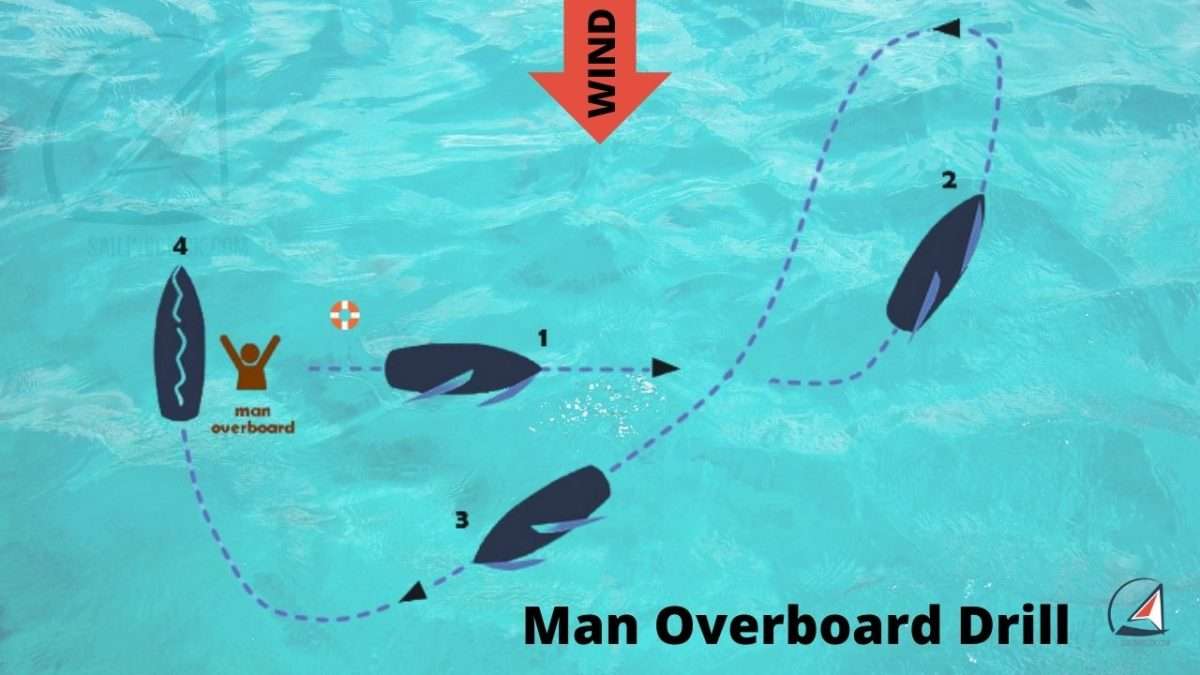
5. Sail Trim Practice
Choose a point of sail and focus solely on perfecting your sail trim. Observe the effects of different trim settings on your boat’s speed and handling. This exercise can be as simple as sailing a straight line or a set course while focusing on sail trim adjustments.
Remember, regular practice is key to improving your sailing skills. Even experienced sailors continually learn and refine their techniques. Be patient with your progress, learn from any mistakes, and celebrate your improvements. Safety should always be your primary concern, so always ensure you are practicing within your abilities and current conditions.
Understanding and effectively using the points of sail is integral to becoming a skilled sailor. These principles allow you to harness the power of the wind, regardless of its direction, and navigate your vessel efficiently and safely across the waters.
From identifying the direction of the wind to adjusting your sails to match each point of sail, we’ve covered the foundations that every sailor, beginner or veteran, needs to master. We’ve delved into the nuances of sail trim, explored common mistakes, and offered practical tips to navigate each point of sail effectively. However, this is just the starting point.
It’s important to remember that sailing is a hands-on endeavor, and the theory must be complemented with real-world practice. The drills and exercises outlined should provide a platform for you to hone your skills, but each time you’re on the water, it’s an opportunity to learn and improve. Whether you’re beating upwind on a close-haul or running downwind with sails fully extended, each experience will deepen your understanding and proficiency.
In the world of sailing, there’s always room for growth and improvement. Keep an open mind, be prepared to learn from your experiences, and continue to explore the wealth of knowledge available. The journey towards mastering the points of sail is a challenging yet rewarding one, filled with moments of insight, achievement, and the sheer joy of being at one with the wind and sea. Safe and happy sailing!
Additional Resources
Continued learning and resource reference is a critical part of becoming a skilled sailor. Here are some suggested resources that can provide further guidance and deepen your understanding of the points of sail and other sailing techniques:
- “The Annapolis Book of Seamanship” by John Rousmaniere: A comprehensive guide that covers all aspects of sailing, including a detailed section on points of sail and sail trim.
- “Sailing For Dummies” by J.J. Isler and Peter Isler: An accessible and informative guide for beginners that explains the basics of sailing, including understanding the wind and mastering the points of sail.
- SailZing’s Points of Sail and Sail Trim YouTube series : This video series provides a visual guide to the points of sail and offers practical advice on sail trim.
- American Sailing Association’s Points of Sail video : A quick, illustrative video explaining the points of sail.
- American Sailing Association’s Sailing Courses : They offer a range of courses, from beginner to advanced, which cover all aspects of sailing, including understanding and using the points of sail.
- Udemy’s Learn to Sail: The Basics : This online course offers beginner-friendly lessons on the fundamentals of sailing, including the points of sail.
- Sail Magazine : This online magazine provides numerous articles, tips, and how-tos on various aspects of sailing.
- Sailing World : Here you can find in-depth articles and expert tips on racing techniques, including mastering the points of sail.
Point of Sail : An easy-to-understand diagram illustrating the points of sail relative to the wind direction.
Remember, mastering the points of sail and their associated sail trim techniques will take time, patience, and plenty of practice. These resources are tools to assist you on your journey, helping you develop the skills and confidence to navigate the open seas successfully.
Numerous resources are available for further learning. Consider taking a certified course from organizations like the American Sailing Association, reading sailing books like “The Annapolis Book of Seamanship”, or exploring online platforms for videos and articles. Practice and experience, however, are the most effective teachers.
Frequently Asked Questions
What are the points of sail.
The points of sail are the course directions that a sailing vessel can take with respect to the wind direction. These include: In Irons (directly into the wind), Close-Hauled (as close to the wind as possible while still moving forward), Close Reach (between close-hauled and beam reach), Beam Reach (wind coming directly from the side), Broad Reach (wind coming from behind at an angle), and Running (wind coming directly from behind).
What is the fastest point of sail?
Generally, a Beam Reach (wind coming directly from the side) is considered the fastest point of sail. This is because the sail works much like an airplane wing, creating lift and propelling the boat forward.
What is the difference between tacking and jibing?
Tacking and jibing are both maneuvers used to change course on a sailboat. Tacking is changing the boat's direction when sailing upwind, while jibing is used when sailing downwind.
How do I know what point of sail I'm on?
The point of sail you're on is determined by the angle between your course and the wind direction. This can be determined visually, by feeling the wind direction, or using instruments on board like a wind vane.
What is sail trim and why is it important?
Sail trim refers to the adjustment of sails in response to factors like wind speed and direction, and the desired course. Proper sail trim allows for efficient sailing and optimal speed, and it varies for different points of sail.
What are some common mistakes when navigating the points of sail?
Common mistakes include improper sail trim for the point of sail, not adjusting the course or sail trim when the wind direction changes, or not using the body weight effectively to balance the boat, especially when close-hauled.
Where can I learn more about points of sail and other sailing techniques?
Numerous resources are available for further learning. Consider taking a certified course from organizations like the American Sailing Association, reading sailing books like The Annapolis Book of Seamanship, or exploring online platforms for videos and articles. Practice and experience, however, are the most effective teachers.
Leave a Review Cancel reply
You must be logged in to post a comment.
You may also like
Sailing spots.

Cruising a Charter Boat Around Scotland’s West Coast and the Hebrides

See the Azores from a Charter Yacht
Yachting basics.

Yacht Anodes: Everything You Need to Know

What to Take on a Yacht? The Ultimate List of Essential Items
Sailing routes.

Sailing Route in the Bahamas

Sailing Route in Croatia, from Pula along the East Coast of Istria and the Islands of Cres, Krk, Losinj.
Yacht events, sailing news.

Celebrating the New Year on a Chartered Sailing Yacht

A Cry from the Deep: The Lampedusa Tragedy Unfolds, 41 Souls Perish in Desperate Quest for Freedom
Faces in yachting.

Unforgettable Journeys: The Legendary Adventures of Sir Francis Chichester

Joshua Slocum: The Lone Mariner’s Odyssey
Boat reviews.

- TOP Charter Deals (updated)
- Advertising and Promotion
- Privacy Policy
- Cookie Policy
Please note that some links on our site are affiliate links. This means we may earn a commission at no extra cost to you if you click on them and make a purchase. We recommend products because we believe they add value, not because of the commission we receive. Your support helps keep our site running. If you have questions, please reach out to us.
Privacy Overview
Change location, find awesome listings near you.
No products in the cart.
Sailing Ellidah is supported by our readers. Buying through our links may earn us an affiliate commission at no extra cost to you.
The 5 Points of Sail Explained
The 5 points of sail describe the angles a sailboat can sail relative to the wind direction, and we have a name for each of them:
- Close-hauled: Sailing close to the wind
- Close reach: Bearing away from the wind
- Beam reach: The wind comes from the side
- Broad reach: Sailing away from the wind
- Running: Sailing downwind.
In this article, I’ll explain the points of sail from Close-hauled upwind sailing to Running downwind. We’ll look at the technicalities of each point and how to trim the sails accordingly. We will also walk through some of the nautical terms associated to make sure you are up to speed. Finally, I’ll share some of my best tips and strategies for downwind sailing with you!
The 5 points of sail explained
I made this points of sail diagram for your convenience. It illustrates the sailing angles to the wind and is helpful to identify the term for what point of sail you are on.
Looking at the illustration, you might wonder why the no-go zone isn’t included as a sixth point. The reason is that you can’t sail a boat directly into the wind. So, technically, it isn’t a point of sail. However, I will include it anyway since you head through this zone every time you make a tack.
I will talk about “true” and “apparent” wind when describing the points, so let’s take a quick look at what that actually means before we move on.
True and apparent wind briefly explained :
True wind speed is the actual wind velocity measured by a stationary object. Apparent wind speed is the wind velocity perceived by an object moving through the air, such as a boat or yourself. In other words, apparent wind speed combines the actual wind and the effective wind created by your motion.
This element is crucial to understand when sailing and of course, I have an excellent article on the topic: Learn more about the difference between true and apparent wind.
NO-GO-ZONE or In Irons – Head to wind
The no-go-zone is where the sail’s angle to the wind prevents it from generating lift. When a sail can’t generate lift, the boat stops, and the sails will start to flop around. This zone is usually about 35 – 45 degrees from the eye of the wind in both directions. That means you always have an area of 70 – 90 degrees towards the direction of the wind that you can’t ‘sail.
There are two occasions you want to have your bow into the wind, though . When hoisting, lowering, and reefing the sails and briefly during a tack. A tack is when you move the sails from one side of the boat to the other as fast as possible to avoid losing the boat’s speed.
1. Close Hauled – Sailing close to the wind
Sailing close hauled is sailing as close to the wind as your boat allows.
Your sails are sheeted in tight, and if you change your course a little bit too much into the wind, your sails will start flopping, and you will lose your speed. The boat is heeling over to the side, which, for some, can be intimidating.
This point of sail is often called beating – with good reason.
The sail trim is crucial, and the person at the helm has to focus on keeping his point. This is also the point of sail where your apparent wind will be the highest in relation to the wind. You will often have waves and swell pounding into the bow, which can be challenging in rough conditions.
Learn more about how high a sailboat can point in this article.
2. Close Reach – Bearing away from the wind
Once you bear away from being close-hauled, you get into close reach. You are now sailing between 50 and 80 degrees, give or take. This is a much easier point of sail as the person at the helm doesn’t have to be as sharp on the course, and you can ease off the sheets and let the sails out a bit.
The boat will usually calm down when bearing away from beating, and you’ll sail faster, too. The apparent wind strength is still higher than the actual wind, making it an efficient way of working yourself toward the wind without knocking your teeth out!
3. Beam Reach – The fastest point of sail
You are on a sweet beam reach once you bear away from a close reach and get to 90 degrees. This is a fast point of sail for most sailboats. The wind is coming from the side, and your true and apparent wind will be at a delta and show about the same speed.
Sheet your sails out about halfway, and the boat will sail fast and comfortably with excellent stability.
4. Broad Reach – Rig your boom preventer
Continuing to bear off from 90 degrees puts you on a broad reach down to about 135 degrees off the wind. You can now ease the sheets as you turn and will feel the wind speed decrease. This is because you are sailing away from it, and your apparent wind speed is now less than your actual wind speed.
Broad reaching is a very comfortable point of sail due to the lack of heeling. On a broad reach, the sail’s shape is less critical, and trimming in a bit of a belly will make it more powerful. You can accomplish this by adjusting the sheeting angle. Move the cars forward until the leech of the headsail is closed. A fluttering sail is an ineffective sail.
A broad reach is a comfortable point of sail; if conditions allow for it, it is the perfect time to get out your light-wind sail!
It is wise to rig up a boom preventer when sailing in any direction away from the wind. A boom preventer is a line run from a strong point ahead of the mast to the end of the boom. Its job is to prevent the boom from swinging over in case of a sudden, fatal wind change.
5. Running – Sailing downwind
The last point of sail is called running. Running is when you are sailing between 135 and 180 degrees downwind. At this point, you need to trim your sails by easing your sails out as much as possible. Be careful not to let the mainsail chafe against the spreaders and shrouds. Rig up your preventer now if you haven’t already!
As you continue past 135 degrees, you’ll see that the apparent wind speed decreases until you sail dead downwind. You’ll also notice that when you bear away from a broad reach, the mainsail will start blocking the wind to the headsail, and you will struggle to make it stand up.
Closing the circle of sailing points
When continuing around the running point, a gybe will put you over on a broad reach again on the opposite tack, and you can continue through the points up towards a close reach again. Then, making a tack will complete your 360-degree circle! Remember that the apparent wind increases when you get past 90 degrees from the wind.
You can read more about different types of sails here.
Sailing through our points of sail – Example
Like I said in the beginning, when we talk about the points of sail, we refer to the wind angles in relation to your sailing direction, not the compass rose.
Let’s take a quick, simplified example:
You are sailing on a course 0 degrees north. The wind is blowing straight from 90 degrees east onto the starboard side of your boat. This means you are sailing on a starboard tack on a beam reach .
A friend tells you about this awesome beach bar not far away, and you want to change your course about 135 degrees to starboard to get there. This means you will eventually get the wind on the other side of the boat as you turn your wheel over to starboard. As you approach a close reach and get close-hauled, you tighten in your sheets and flatten your sails to keep the speed and momentum.
Once you get past 45 degrees heading, your sails will flap as you turn your bow straight into the wind or the no-go zone . Now you need to make a tack. This means moving your sails over from port to starboard.
As your heading gets close to 135 degrees, the sails will fill with wind again, and you are now sailing close-hauled on a port tack.
You also notice that the wind feels stronger because you’re sailing upwind.
Nautical terms used when sailing and navigating
Port Tack – When the wind blows on the port side of your sails
Starboard Tack – When the wind blows on the starboard side of your sails
Tacking – When you steer the boat from a starboard tack to a port tack and vice versa upwind .
Gybing- When you steer the boat from a starboard tack to a port tack and vice versa downwind .
Heeling – When the wind fills the sails and leans the boat over to the side.
Boom preventer – A line or rope tied to the end of the boom and led forward of the mast to prevent it from swinging over when sailing off the wind.
Overpowered – When wind surpasses the boat’s ability to steer a straight course. This typically happens when you try to sail the vessel above your hull speed, carry too much sail area in strong winds, or trim your sails poorly.
Hull Speed – The speed at which your boat is sailing when its created wave has the same length as the hull’s water length. Displacement sailboats get hard to steer when going faster than this.
You can learn more sailing terms in my sailor’s guide to nautical terms here .
Final words
There you have it! You now know your points of sailing and that they refer to the vessel’s angle relative to the direction of the true wind. You also learned that a sailboat cannot sail directly into the wind. Finally, we reviewed some good sailing options downwind and looked at some relevant sailing terminology. Now you have to hoist the sails and head out at sea!
FAQ – The 5 Points of Sail
What are the parts of a sail called.
The parts of a sail and their functions are as follows:
- Tack : This is the lower forward corner of the sail, anchoring it at its front bottom edge.
- Clew : Located at the lower aft (rear) corner, the clew is the point where the sail’s bottom and aft edges meet.
- Head : This is the sail’s top corner, opposite the tack and clew.
- Foot : The foot is the bottom edge of the sail, stretching between the tack and the clew.
- Luff : The luff refers to the sail’s front edge, running vertically between the tack and the head.
- Leech : The leech is the aft or rear edge of the sail, extending from the clew to the head.
- Telltales : These are small ropes, bands, or flags attached to the sail, which provide visual cues about the airflow around the sail.
- Battens : Battens are rigid elements, such as slates or tubes, inserted into pockets on the mainsail. They help maintain the sail’s shape and extend its lifespan.
You can read more in-depth about the parts of a sail here .
What are sail poles called?
“Spar” is the general term for a pole made of a solid material like wood or metal used to support a boat’s sail.
These include:
- Mast : A tall, vertical pole that supports the sails.
- Boom : A horizontal pole attached to the mast. It extends from the bottom of the mainsail, helping to control the angle and shape of the sail.
- Spinnaker Pole : A pole used to extend the foot of a spinnaker sail away from the boat, helping to stabilize and maximize the surface area of the sail.
- Whisker Pole: A pole used to hold out the clew of a headsail, like a jib or genoa, when sailing downwind.
- Bowsprit : Though not always considered a pole, a bowsprit is a spar extending from the vessel’s bow and typically used to support the tack of a headsail.
- Gaff : In traditional gaff-rigged sailboats, a gaff is a horizontal pole that, along with the boom, supports the top of a four-cornered sail.
You can read more about the different parts of a sailboat here .
Which point of sail is the fastest?
Beam Reach is the fastest, easiest, and most comfortable point of sail for most sailboats. The wind comes in from the side, and you have your sails about halfway out. When your sails are well trimmed, this is an efficient point that will allow you to sail fast with excellent stability in your boat.
Is it better to sail upwind or downwind?
What’s best between sailing upwind and downwind depends on where your destination is. Remember that your boat won’t be able to sail directly upwind but at an angle of about 35 degrees to your apparent wind direction.
Sailing downwind is comfortable, but ensure your boom preventer is in place for the deepest sailing angles. Also, remember that you will require more wind to sail downwind efficiently as your apparent wind speed is lower than the true wind speed. With enough wind, however, broad-reaching is a fantastic point of sail.
What are the three main points of sail?
The three main points of sail are:
- Beating: When sailing as close to the wind as your boat allows, typically 35-45 degrees.
- Reaching: Includes Close reach, Beam Reach, and Broad reaching, which means you are sailing between 50 and 120 degrees.
- Running: When you are sailing at lower angles than 120 degrees.
Sharing is caring!
Skipper, Electrician and ROV Pilot
Robin is the founder and owner of Sailing Ellidah and has been living on his sailboat since 2019. He is currently on a journey to sail around the world and is passionate about writing his story and helpful content to inspire others who share his interest in sailing.
Leave a Reply Cancel reply
Your email address will not be published. Required fields are marked *

The 6 Points of Sail: Diagram of Wind Direction and Sail Trim
Points of sail are the different angles at which a sailboat can sail in relation to the wind. Understanding these points is crucial for anyone who wants to learn how to sail, and it’s usually taught in sailing schools. Each point has its own characteristics that determine the boat’s speed and direction.
The main points of sail are:
- Into the wind: The no-sail zone
- Close-hauled: Sailing as close to the wind direction as possible.
- Close reach: Sailing between a beam reach and close-hauled, at an angle to the wind.
- Beam reach: Sailing perpendicular to the wind, with the wind hitting the side of the sail.
- Broad reach: Sailing with the wind coming from behind at an angle.
- Running: Sailing directly downwind, with the wind coming from behind.
Understanding how to navigate through each point of sail effectively takes practice and patience. It’s important to know your boat’s capabilities and limitations so you can adjust your technique accordingly.
Points of Sail
To comprehend the points of sail, it is essential to grasp the relationship between a sailboat’s trajectory and the direction of the true wind. The points of sail encompass a full 360-degree circle, each segment representing a distinct sailing direction.

1. In Irons (Into the Wind)
Embarking on our journey, we encounter the point of sail known as “into the wind” or “in irons.” This position aligns your sailboat directly into the wind, within a range of plus or minus 45 degrees from 0 degrees. While this point of sail hinders forward progress, it serves as a pivotal moment for executing various sailing maneuvers, such as tacking and mast adjustments.
Tacking involves transitioning from one side of the wind to the other, crossing the into the wind point of sail. It is crucial to navigate this maneuver swiftly, as prolonged exposure in this “no-go zone” can impede momentum. Should you fail to traverse this point expediently and become stuck, it is referred to as being “taken aback.”
2. Close Hauled
Advancing beyond the into the wind point of sail, we arrive at the close hauled position. Sailing close hauled refers to navigating upwind, moving toward the wind’s direction. This point of sail, often referred to as “beating” or “working windward,” offers an intimate connection with the wind, enriching your experience as both captain and crew member.
During close hauled sailing, your sail assumes the role of an airplane wing, cutting through the wind head-on and generating optimal lift. Precise sail trim is paramount in this configuration, with tighter adjustments maximizing the sailboat’s ability to “point” towards the wind and optimize performance.
3. Close Reach
Continuing our voyage, we transition from close hauled to the close reach point of sail. Positioned between close hauled and beam reach, this segment represents a thrilling and rapid sailing direction. Sailors often revel in the exhilaration offered by the close reach point of sail.
Close reach resides closest to the “no-go zone” compared to other points of sail. It’s important to pay close attention to the wind and how the sails are set when sailing close reach. The sail needs to be tight, like when sailing close hauled, but loose enough so it’s just not luffing . This will help the boat sail efficiently when sailing upwind.
4. Beam Reach
As our sailboat maneuvers further away from the wind’s direction, we arrive at the beam reach point of sail. In this configuration, the sailboat is perpendicular to the wind, either on the starboard or port side. Notably, the beam reach point of sail boasts both speed and comfort, making it a preferred choice among sailors.
At beam reach, your sails are partially let out, the wind’s interaction with the sails in this position optimizes energy transfer from the lateral force to forward propulsion. The result is a harmonious conversion of wind power into the sailboat’s forward motion, ensuring an exhilarating and controlled sailing experience.
5. Broad Reach
Progressing from the beam reach, we venture into the realm of the broad reach point of sail. As we veer further downwind, the sails are let out approximately two-thirds of their capacity. At this stage, the wind doesn’t approache directly from astern but at an angle. As a consequence, the sail begins to function more like a parachute, relying on air resistance to maintain momentum.
While sailing on a broad reach, you will experience a less intense sensation of wind, yet your sailboat will continue to make steady progress. The sailboat’s orientation during this point of sail evokes a sense of descending down a slope. The serenity of the wind’s speed, coupled with the reliable forward movement, makes the broad reach a personal favorite among many sailors.
Our final point of sail brings us to the running point—a sailboat’s true downwind trajectory. In this configuration, the sails are fully let out, allowing the wind to propel the sailboat directly from behind. The experience of sailing on a running point is akin to running downhill, with the force of the wind acting as a powerful propeller.
Also known as a “dead run,” the running point of sail demands minimal attention to sail trim but requires careful attention to prevent an accidental jibe. Depending on wind conditions, this point presents an opportunity to hoist a gennaker or spinnaker sail, optimizing the sailboat’s performance when sailing directly downwind. The consistent wind direction and intensity make it an ideal moment to embrace the vibrant colors and expansive sails.
Conclusion for Points of Sail
In conclusion, understanding the fundamentals of sailing directions is crucial for any sailor. Knowing how to navigate each point of sail can make the difference between a successful voyage and a disastrous one. From sailing into the wind to running downwind with ease, each direction presents its own set of challenges and rewards.
Close hauled and close reach requires precision and skill, while beam reach provides a comfortable ride, and broad reach allows for thrilling surfing. Running downwind requires careful attention to prevent an accidental jibe.
As with any skill, practice makes perfect. Take time to familiarize yourself with each point of sail and experiment with different techniques. With patience and perseverance, you will soon become proficient in navigating all directions.
Remember that safety should always come first when out on the water. Always wear appropriate gear and follow proper procedures to ensure a safe journey.
How do I determine the point of sail I’m on?
To determine your point of sail, observe the angle of the wind relative to your boat. Look at the direction the wind is coming from and compare it to the direction your boat is heading. Adjust your sails accordingly to optimize your performance and balance.
What constitutes the best point of sail?
Determining the best point of sail is subjective and varies based on personal preference. However, the beam reach point of sail stands out as the fastest and most comfortable configuration. The optimal balance between lateral wind force and resisting keel force facilitates unparalleled forward movement on a sailboat.
How does the point of sail affect the boat’s heel?
The point of sail has a significant impact on a boat’s heel or stability. When sailing upwind, the boat tends to heel more due to the higher force generated by the sails. As you bear away and sail downwind, the boat’s heel decreases, and it becomes more stable. Proper sail trim can help maintain a balanced heel and overall stability throughout different points of sail.
Similar Posts

How to Sail Around the World on a Budget
Sailing around the world is a dream for many adventurers, but the idea of circumnavigating the globe can seem daunting, especially when considering the potential costs involved. However, with careful planning, a bit of know-how, and a willingness to live frugally, it’s possible to embark on this adventure without breaking the bank. In this article,…

13 Beginner Sailing Tips: Your Guide to Getting Started
Sailing can be an exhilarating experience, but for beginners, it can also be overwhelming. The thought of controlling a boat while being surrounded by water may seem daunting, but fear not, with the right knowledge and preparation, anyone can learn how to sail. In this article, we will share some beginner sailing tips that will…

Basic Sailing Terminology: Sailboat Parts Explained
Sailing is a timeless activity that has captivated the hearts of adventurous souls for centuries. But, let’s face it, for beginners, sailing can be as intimidating as trying to navigate through a dark, labyrinthine maze with a blindfold on. The vast array of sailing terminology, sailboat parts and jargon can seem like a foreign language…

Top Sailing Safety Tips for Beginner Sailors
Sailing on a yacht is a thrilling experience that allows you to explore the beauty of the open water. However, it’s important to prioritize safety when embarking on a sailing trip. Yacht safety is not only essential for the protection of those on board, but also for the boat itself. Neglecting safety protocols can lead…

Navigating Life’s Storms: 7 Life Lessons from Sailing
Sailing is more than just a hobby; it is a lifestyle that can help you develop a wide range of skills and abilities. Whether you are a seasoned sailor or just starting, the 7 life lessons from sailing can be applied to various aspects of your life, from your personal relationships to your professional endeavors….
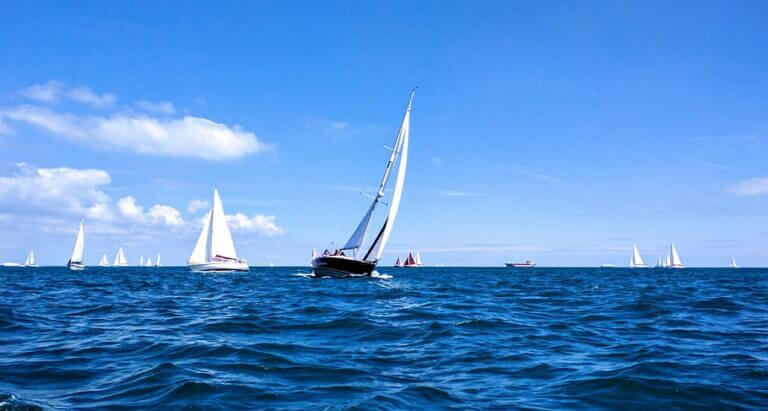
10 reasons why sailing is the best way to travel
Are you feeling restless and looking for a new way to explore the world? Tired of being cooped up in airplanes, trains, or cars for hours on end? Well, why not try something different and embark on a sailing adventure? While I may not be a seasoned sailor myself, I can tell you that there’s…
The different points of sail and their uses
Understanding the different points of sail is crucial for efficient sailing and navigating your boat effectively in any wind condition.
The Different Points of Sail and Their Uses
Sailing is an incredible way to explore the world, spend quality time with your family, and embrace the freedom of the open sea. If you’re new to sailing, it’s essential to understand the different points of sail and how to use them effectively. In this comprehensive guide, we’ll cover everything you need to know about the various points of sail, their uses, and how to navigate your boat efficiently in different wind conditions.
Table of Contents
Introduction to points of sail, close-hauled, close reach, broad reach, sailing upwind and downwind, tacking and gybing.
Points of sail are the various angles between your boat’s heading and the direction of the wind. Understanding these angles is crucial for efficient sailing, as it allows you to harness the wind’s power to propel your boat in the desired direction. There are six primary points of sail:
Each point of sail has its unique characteristics and uses, which we’ll explore in detail below.
The no-go zone, also known as the “irons” or “dead zone,” is the area directly into the wind where a sailboat cannot sail. This zone typically spans about 45 degrees on either side of the wind direction. If you try to sail directly into the wind, your sails will start to flap, and your boat will lose forward momentum.
To avoid getting stuck in the no-go zone, you’ll need to sail at an angle to the wind, either by tacking (zig-zagging) upwind or by changing your course to a more favorable point of sail.
Close-hauled, also known as “beating” or “working to windward,” is the point of sail where your boat is sailing as close to the wind as possible while still maintaining forward momentum. This angle is typically around 45 degrees off the wind direction, although the exact angle depends on your boat’s design and sail trim.
Sailing close-hauled is essential when you need to make progress upwind, such as when you’re heading towards a destination that’s directly upwind of your current position. To sail efficiently on a close-hauled course, you’ll need to trim your sails tightly and maintain a steady course to maximize your boat’s speed and pointing ability.
A close reach is the point of sail where your boat is sailing at an angle between close-hauled and a beam reach, typically around 60 degrees off the wind direction. This point of sail offers a balance between speed and the ability to sail upwind, making it a popular choice for cruising and racing sailors alike.
On a close reach, you’ll need to ease your sails slightly compared to sailing close-hauled, allowing them to generate more power and propel your boat forward. This point of sail is ideal for covering ground quickly while still maintaining the ability to sail upwind if needed.
A beam reach is the point of sail where your boat is sailing perpendicular to the wind direction, with the wind coming directly across the side (or “beam”) of your boat. This point of sail is often considered the fastest and most comfortable, as it allows your boat to achieve maximum speed without excessive heeling (leaning) or pounding through waves.
On a beam reach, you’ll need to ease your sails even more than on a close reach, allowing them to catch the full force of the wind and generate maximum power. This point of sail is perfect for covering long distances quickly and enjoying the thrill of sailing at high speeds.
A broad reach is the point of sail where your boat is sailing at an angle between a beam reach and running, typically around 135 degrees off the wind direction. This point of sail offers a balance between speed and stability, making it a popular choice for downwind sailing in moderate to strong wind conditions.
On a broad reach, you’ll need to ease your sails even more than on a beam reach, allowing them to generate power while minimizing the risk of accidental gybes (when the wind catches the back of the sail and causes the boom to swing across the boat). This point of sail is ideal for fast downwind sailing while maintaining control and stability.
Running, also known as “sailing downwind” or “sailing before the wind,” is the point of sail where your boat is sailing directly away from the wind, with the wind coming from directly behind your boat. This point of sail is the slowest and least efficient, as your sails are unable to generate much power when the wind is directly behind them.
To sail efficiently on a run, you’ll need to use a technique called “wing-on-wing” or “goose-winging,” where you position your mainsail on one side of the boat and your headsail (such as a jib or spinnaker) on the other side. This configuration allows your sails to catch the wind and propel your boat forward, although it requires careful attention to prevent accidental gybes.
Sailing upwind (towards the wind) and downwind (away from the wind) are two fundamental concepts in sailing, as they determine your boat’s ability to make progress towards your destination. As we’ve seen in the points of sail above, sailing upwind requires a series of tacks on a close-hauled course, while sailing downwind involves a combination of broad reaches and runs.
Understanding how to sail efficiently upwind and downwind is crucial for successful sailing, whether you’re cruising with your family or competing in a race. By mastering the different points of sail and their uses, you’ll be able to harness the wind’s power and navigate your boat effectively in any wind condition.
Tacking and gybing are two essential maneuvers in sailing, allowing you to change your boat’s direction relative to the wind and transition between different points of sail. Tacking is the process of turning your boat’s bow (front) through the wind, while gybing involves turning your boat’s stern (back) through the wind.
Both maneuvers require careful coordination and timing, as well as a thorough understanding of the different points of sail and their uses. By practicing tacking and gybing regularly, you’ll become more confident in your sailing abilities and better equipped to handle a variety of wind conditions and sailing scenarios.
Understanding the different points of sail and their uses is a crucial aspect of becoming a skilled sailor. By mastering these concepts, you’ll be able to navigate your boat efficiently in any wind condition, making the most of your time on the water and enjoying the freedom and fulfillment that comes from sailing with your family.
Whether you’re just starting your sailing journey or looking to improve your skills, we hope this guide has provided you with valuable insights and practical advice to help you on your way. Fair winds and following seas!

- Sailing Resources

Download this cheat sheet to sail faster, cheaper and smarter.
Points of Sail Basics: How to Navigate Your Boat Like a Pro
If you’re interested in sailing, then understanding the points of sail is a fundamental concept that you must grasp. Knowing the points of sail will help you navigate your boat in any direction and under any wind conditions. In this article, we’ll introduce you to the six points of sail and explain how they work.
The six points of sail are into the wind (in irons), close-hauled, close reach, beam reach, broad reach, and running. Each of these points of sail represents a different angle between the boat’s direction and the wind direction. You’ll need to adjust your sails and your boat’s course to navigate effectively through each of these points.
Whether you’re a beginner or an experienced sailor, understanding the points of sail is crucial to your success on the water. By the end of this article, you’ll have a solid understanding of the six points of sail and how to use them to navigate your boat. So, let’s dive in and explore the world of points of sail!
Basics of Sailing
Sailing is an exciting and rewarding activity that requires some basic knowledge of how a sailboat works. In this section, we will cover the basics of sailing and introduce you to the Points of Sail.
Points of Sail Overview
The Points of Sail refer to the different angles of sailboat travel relative to the wind. There are five main points of sail: Close Hauled, Beam Reach, Broad Reach, Running Downwind, and No-Sail Zone. Each point of sail has its own set of characteristics and requires different sail trim and steering techniques.
Close Hauled
Close Hauled is the point of sail closest to the wind. When sailing close hauled, your sailboat is angled towards the wind, and the sails are trimmed in tight. This point of sail is the slowest, but it allows you to sail as close to the wind as possible.
Beam Reach is when the sailboat is sailing perpendicular to the wind. This point of sail is faster than Close Hauled, and the sails are trimmed out slightly. The boat will heel (lean) to one side, and the sails will fill with wind.
Broad Reach
Broad Reach is when the sailboat is angled away from the wind. This point of sail is faster than Beam Reach, and the sails are trimmed out even further. The boat will heel more, and the sails will be full of wind.
Running Downwind
Running Downwind is when the sailboat is sailing directly downwind. This point of sail is the fastest, and the sails are trimmed out all the way. The boat will heel significantly, and the sails will act more like a parachute than a wing.
No-Sail Zone
The No-Sail Zone is directly upwind of the sailboat. It is impossible to sail directly into the wind, so this area is not considered a point of sail. If you find yourself in the No-Sail Zone, you will need to tack (zig-zag) to make progress towards your destination.
In conclusion, understanding the Points of Sail is fundamental to sailing. Each point of sail requires different sail trim and steering techniques, and mastering them will allow you to sail efficiently and safely.
Advanced Sailing Techniques
As you gain more experience and confidence in sailing, you can start to explore more advanced sailing techniques to improve your speed, efficiency, and overall performance. Here are some techniques that you can practice and master:
Tacking and Jibing
Tacking and jibing are two essential maneuvers that allow you to change the direction of your sailboat when sailing upwind or downwind. Tacking involves turning the bow of the boat through the wind, while jibing involves turning the stern of the boat through the wind. You need to adjust the sails and the rudder to maintain your speed and momentum during these maneuvers.
When tacking, you want to keep the sails trimmed in as you turn the boat through the wind. Once the sails start to luff, you can release the jib sheet and let the sail flap briefly before trimming it in on the new tack. You also need to turn the rudder smoothly to avoid losing speed and steer a course close to the wind.
When jibing, you need to be careful not to let the boom swing across the boat too quickly or forcefully, as this can cause damage or injury. You want to ease the mainsheet gradually as you turn the boat downwind and trim it in on the new tack. You also need to steer a course that allows the wind to fill the sails smoothly and avoid accidental gybes.
Sail trim refers to the adjustment of the sails to optimize their shape and angle to the wind. Proper sail trim can help you achieve maximum speed, pointing ability, and balance in different wind conditions. You need to pay attention to the telltales, or small ribbons attached to the sails, to see if they are flowing smoothly or stalling.
When sailing upwind, you want to trim the sails in as close to the centerline of the boat as possible, while keeping them slightly eased to maintain airflow. You also want to adjust the twist, or the difference in angle between the top and bottom of the sail, to match the wind velocity and direction. Too much twist can cause the sail to stall or luff, while too little twist can cause it to be overpowered or stalled.
When sailing downwind, you want to ease the sails out to catch more wind and increase your speed. You also want to adjust the shape of the sails to create a broad, curved surface that captures the wind more efficiently. You can use a spinnaker or a gennaker to add more sail area and power.
Wind Shifts
Wind shifts are changes in wind direction that can affect your sailing course and strategy. You need to be aware of the wind shifts and adjust your sails and course accordingly. A wind shift can be caused by a variety of factors, such as thermal effects, pressure gradients, or land effects.
When sailing upwind, you want to look for signs of wind shifts, such as changes in wind velocity, direction, or temperature. You also want to keep an eye on other boats and objects on the water to see if they are affected by the wind shifts. If you notice a wind shift, you can adjust your sails and course to take advantage of it and gain an advantage over your competitors.
When sailing downwind, you want to anticipate the wind shifts and adjust your course and sails accordingly. You also want to avoid sailing in the lee of other boats or objects that can create wind shadows and disrupt your airflow. If you encounter a wind shift, you can use it to your advantage by adjusting your course and sails to catch more wind and increase your speed.
In summary, mastering advanced sailing techniques such as tacking and jibing, sail trim, and wind shifts can help you become a more skilled and confident sailor. Practice these techniques in different wind conditions and situations to improve your sailing skills and enjoy the thrill of sailing.

Safety Considerations
When sailing, safety should always be a top priority. Here are some important safety considerations to keep in mind while out on the water.
Capsizing and Righting the Boat
Capsizing is when the boat overturns and ends up upside down in the water. This can happen if the boat is hit by a large wave or if the wind suddenly changes direction. If the boat capsizes, it’s important to stay calm and follow the proper procedures to right the boat.
First, make sure everyone on board is wearing a life jacket. Then, try to right the boat by pulling on the centerboard or keel. If this doesn’t work, try to climb onto the overturned hull and use your weight to right the boat. Once the boat is righted, bail out any water and continue sailing.
Man Overboard Procedures
If someone falls overboard, it’s important to act quickly to ensure their safety. The first step is to shout “Man overboard!” to alert the rest of the crew. Then, throw a lifebuoy or other flotation device to the person in the water.
Next, turn the boat around and head back towards the person in the water. Keep a close eye on them and try to maneuver the boat as close as possible without putting anyone else in danger. Once you’re close enough, use a boat hook or other tool to help the person back onto the boat.
Remember, safety is always the top priority when sailing. By following these procedures and staying vigilant, you can help ensure a safe and enjoyable sailing experience for everyone on board.
Mike Sellers


My Cruiser Life Magazine
Points of Sail Explained
The points of sail refer to the boat’s current angle compared to the wind’s direction. For example, if you are headed directly into the wind, you are “in irons.” If you are headed away from the wind, you are “running.” Here’s a look at the basic points of sail and how they apply to the typical cruising boat.
Table of Contents
Points of sail degrees, port tack and starboard tack, irons sailing, close hauled sailing, close reach sailing, beam reach sailing, broad reach sailing, sailing upwind, reach sailing, changes in wind direction, keep sailing, points of sail faqs.
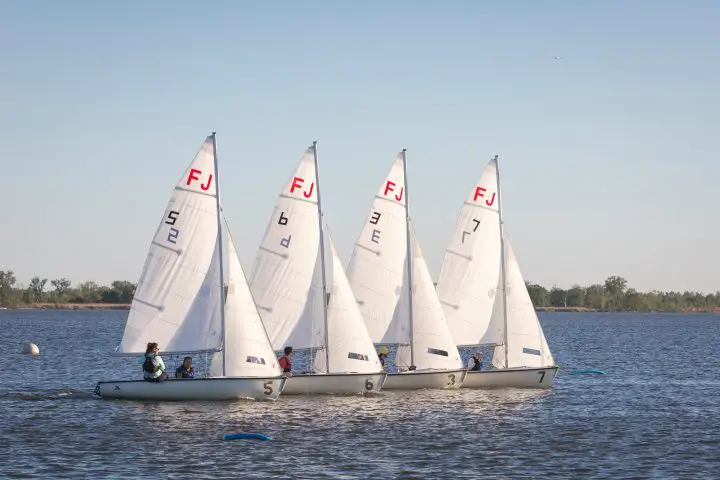
Different Points of Sail
You might have heard of the sailing terms reach, run, and close-hauled. Sailors use the points of sail to discuss their current sailing direction and communicate changes.
For example, if a boat is sailing on a beam reach, the skipper might ask the helmsperson to try a close haul. The helmsperson will know that instead of keeping the wind directly from the boat’s beam, they need to sail upwind.
A sailboat could be pointed any of 360 degrees. When thinking of the points of sail, the wind is coming from 0 degrees. If you are headed directly into the wind, you are in irons. If you are headed 90 degrees off the wind, you are on a beam reach.
If the wind is coming from the boat’s port side, this is a port tack. If the wind is coming from the starboard side, this is a starboard tack.
If you are the helmsperson looking forward towards the bow, the boat’s starboard side is on your right. The port side of the boat is on your left.
When you are heading directly into the wind, you are in irons. It is aerodynamically impossible to actually sail into the wind.
If a skipper keeps the boat in irons, the sailboat will slow down, lose forward momentum, and eventually stop. When the boat slows below about two knots, it also loses steerage. The rudder is no longer effective when the vessel is completely in irons.
Skippers might purposefully put the boat in irons to rescue crew overboard, pick up a mooring, or dock the boat.
If a boat is turning into the wind and wants to keep sailing, skippers avoid irons sailing. Because the boat slows down so quickly and loses steerage, it can be hard to get the sailboat moving again.
Boaters get in irons when they don’t tack fast enough. For example, if a sailor is sailing upwind and wants to switch from a starboard tack close haul to a port tack close haul, they will execute the tack. The boat needs to move across the wind as quickly as possible and keep forward momentum.
The skipper must recover if a boat doesn’t tack fast enough through the wind and ends up in irons. The skipper can backwind the jib to get some momentum going. Sometimes moving the rudder will help enough to get the boat sailing again.
Because the boat cannot keep sailing in irons, this point of sailing is also called “No Go” or “No Sail Zone.” While it is typically less than 45 degrees off the wind, each boat has a different “No Go Zone.” Some boats sail better into the wind, and some can’t sail any closer than 65 degrees off the wind.
When a boat is sailing close-hauled, it is heading towards the wind but not directly into it. This point of sail lies about 45 degrees off the wind. Being close-hauled is also referred to as beating into the wind or simply “beating.” When you are close hauled, you are very aware of the strength of the wind. Waves are more impactful and may be hitting the boat and make for a wet ride.
Sailors must be careful not to get too close to the wind on a close haul. Their sails will luff and be less efficient if they head up into the wind too much.
Sailors can be close-hauled on a port or starboard tack.
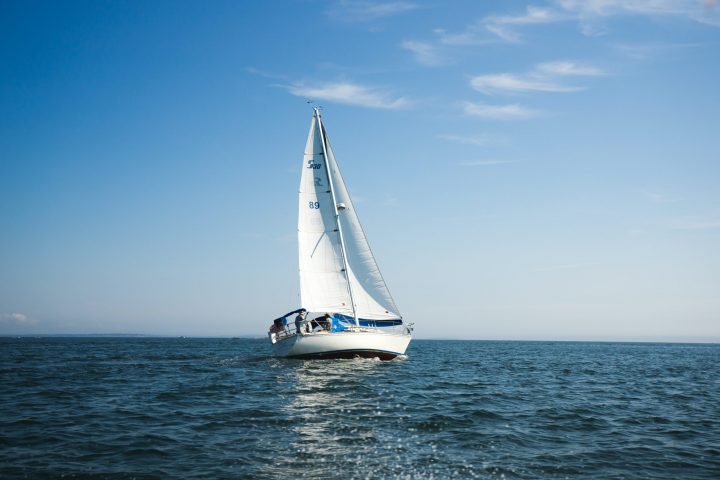
Close reach sailing is a popular and fast point of sail. Greater apparent wind speeds equal greater sailing speeds. This point of sail is more comfortable than a close haul sail setting.
Sailors can be on a close reach on a port or starboard tack.
Sailing on a beam reach is often a sailor’s favorite sailing point. The boat is sailing 90 degrees off the wind, and the wind is coming directly onto the boat’s beam. Sailing on a beam reach is fast. A boat will heel over the most on a beam reach.
You can be on a beach reach on a port or starboard tack.
When you are sailing on a broad reach, you are sailing downwind. Instead of using lift to move the boat, the boat now relies on wind filling the sails. Because you experience less apparent wind on this point of sail, you will sail slower than if you were headed upwind.
You can be on a port or starboard tack when sailing broad reach.
Running happens when the boat is sailing directly downwind. Dead downwind refers to the point of sail that’s 180 degrees off the wind. Sailors who are running often fly a big sail, such as a bright spinnaker, to catch as much wind as possible. Running downwind is a slower point of sail.
Sailors have to pay close attention to the wind direction as any change could cause the boat to jibe. When a sailboat jibes, the boom suddenly moves from one side of the boat to another. Depending on how much wind force is on the mainsail, a jibe can cause damage. It could also hit a crew member.
Because of the danger to the crew and the boat, running downwind is the most dangerous point of sail.
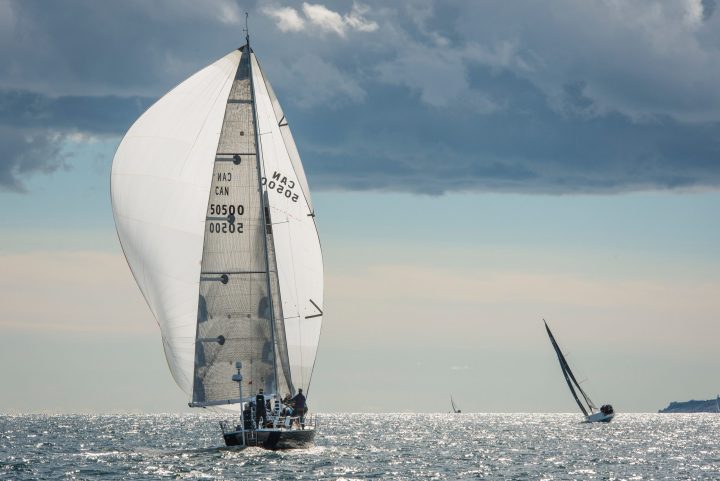
Practicing the different points of sailing is a great way to practice perfecting your sail trim skills. As you move from sailing 45 degrees off the wind, to reach sailing, to sailing with the wind, you can practice easing and tightening the sheets for the most efficient sailing on each point of sail.
When you are sailing upwind, the sheets will be sheeted in tightly. If you sail too close to the wind, the head sail will luff. If you are beating into the wind and tacking back and forth, you want to keep making headway towards your destination. Therefore, you want to keep sailing as close to the wind as your boat will allow.
You can sail on a close reach, beam reach, or broad reach. The more you sail downwind, the more you will loosen the sheets and let out your sails.
What is a Reach in Sailing?
If you’ve ever heard the sailing term reach, you must know that reaching is a popular point of sail. Sailing on a close, beam, or broad reach is forgiving. You won’t fall into irons or jibe the boat if you sail a few degrees off course.
When you are running, you are downwind and sailing with the wind. Sailors will need to pay close attention to this point of sail to avoid an accidental jibe. The sails will be let out to their maximum capacity to catch as much wind as possible.
When focusing on sail trim, skippers should monitor the direction of the wind and wind speed. Their tactics and sail trim will also have to shift if the wind shifts. A change in direction of the wind will be most noticeable on a close haul or when running.
Sailors often practice all the points of sail when taking lessons. Learning the different points of sail and the best sail trim means that sailors can efficiently sail from one place to another. Whether you are beating upwind, on a sailing reach, or running downwind, you can have fun while harnessing and managing the wind’s power.
What are the 8 points of sail?
The eight points of sail include the different points of sail on both a port and starboard tack. These points of sail can be viewed as if on a clock. In Irons Close Hauled Port Tack Beam Reach Port Tack Broad Reach Port Tack Running Broad Reach Starboard Tack Beach Reach Starboard Tack Close Hauled Starboard Tack
What are the 3 points of a sail?
The three points of sail are close-hauled, reaching, and running.
Matt has been boating around Florida for over 25 years in everything from small powerboats to large cruising catamarans. He currently lives aboard a 38-foot Cabo Rico sailboat with his wife Lucy and adventure dog Chelsea. Together, they cruise between winters in The Bahamas and summers in the Chesapeake Bay.
Leave a comment
Your email address will not be published. Required fields are marked *
Save my name, email, and website in this browser for the next time I comment.
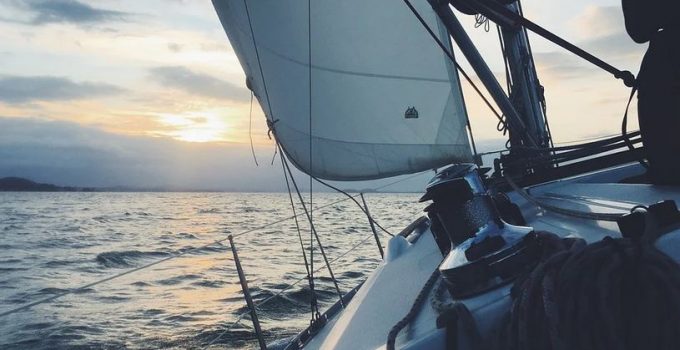
Points of Sail: The Ultimate Guide
The points of sail are very important to any sailor, but can be a little confusing to the novice sailor. In this posting we will go over each point of sail in detail and explain what it means to you when you are sailing.
Basic Sailing Zones
To start off with, let’s talk about some of the basic sailing zones. Each one of these zones is defined by the direction the wind is coming.

No Go Zone – When the wind is blowing directly on the bow (front) of the boat or directly in your face, then you are in the “no go” zone. This zone is about 45 degrees on either side of the direction of the wind. Sails won’t work when they is no angle between the wind and the sail. How a sail works is discussed more here.
Close Hauled (Sailing upwind) – At this angle, you are sailing as close to the direction of the wind as you possibly can. This point of sail is called close hauled because the sails are hauled in as close to the boat as possible. It is also known as pointing or beating.
Beam Reach (Sailing Crosswind) – In this zone you are sailing at a 45-degree angle to the wind. When the wind is blowing across the boat, you are reaching. This is usually the fastest and the most comfortable points of sail.
Broad Reach (Sailing Downwind) – At this angle you are sailing downwind as close as you can without running directly downwind.
Running Downwind – In this zone you are sailing directly downwind and the sails are acting more like a parachute than they are a wing. This is also a dangerous zone to sail in because of the possibility of an accidental jibe.
Detailed Points of Sail
This is a picture with a little more detail. These are all of the basic points of sail that you will ever need to learn. Let’s talk about each in detail.

In Irons (Into the wind) – When you are trying to sail directly into the wind, you are considered “In Irons”. You will hear this term a lot when you are learning to sail. When you are in irons, you lose all forward momentum and can come to a stop. When turning the boat, you will go through this zone and must keep up your momentum to make it all the way through. If you are anchoring or need to stop the boat for any reason, man overboard for instance, the first thing you will want to do is turn into the wind. This is also the zone that you will go to when raising or lowering your sails, since it takes all the pressure off the sail.
Close Hauled – This is as close to sailing into the wind as you can get. You pull the sails in close the boat and point the boat just to the port (left) or starboard (right) of the wind direction.
Close Reach – At this point of sail, you are still sailing in the direction of the wind, but you are a little more to the port (left) or starboard (right) of the wind direction. As you can tell from the diagram, you have to let the sails out a little to still get lift from the wind.
Beam Reach – When you are sailing 45 degrees to the wind , you are on a beam reach. As you can see in the diagram, the sails have to be let out, even more, to still provide lift. The true wind will be coming directly across the boat if it was sitting still.
Broad Reach – At this point of sail, you are starting to sail downwind and the sails are starting to act as a parachute instead of providing lift like a wing. When sailing downwind, this is the safest angle to be doing it at.
Running – When you are sailing directly downwind, you are considered running. Your sails are acting as parachutes and the wind is pushing you. This is the most dangerous way to sail downwind or basically to sail at all. When you are running and the sails are out to each side like this, it only takes a little shift of the wind to make the sail switch sides. This is called an “accidental jibe” and it can be devastating if you are in the path of the boom as it changes sides of the boat. If you look at the two sailboats, in the above image, that is both “running”, you will see that the sails are on different sides of the boat. This is very easy to make accidentally happen. So remember, don’t sail directly downwind unless you have too and if you do, pay close attention to the wind!!
Got any questions about the points of sail or just want to add more to what I have written? Leave a comment below and help make this post even better!
Related Posts
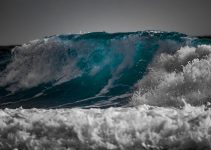
Do you know your points of sail?
Navigating the basics of sailing: a beginner's guide to the points of sail..
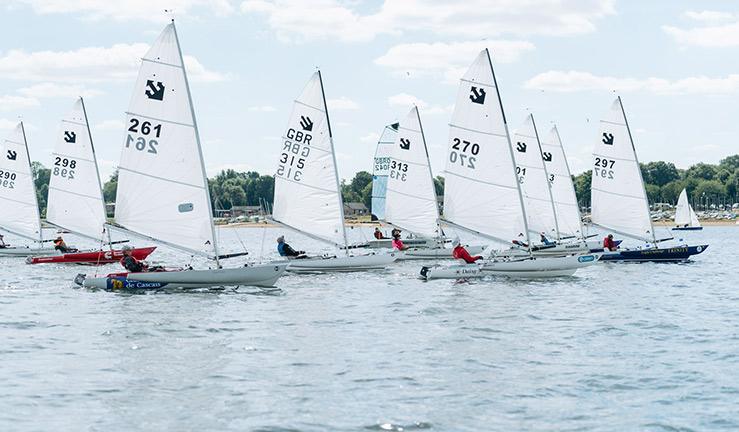
When sailing there are different 'points of sail' to consider, which refer to your boat's course in relation to the wind.
Skilful sailors are always wind-aware, working out where the wind is coming from and how hard its blowing. It’s important to remember that the wind changes direction and the more you practice identifying where the wind is coming from, the more instinctive it becomes.
When starting out in sailing, it’s important to learn about the different directions you can safely and effectively sail your boat. These are called the points of sail. There are seven main points to know about and each one refers to your boat’s course in relation to the wind.
Let’s have a closer look at each of the points of sail:
.jpg)
- No go zone: This is the direction that you can’t sail in. Your sails will start to flap, and your boat will come to a stop.
- Close hauled: This is as close to the wind as you can go. You'll need to make sure your sails are pulled in nice and tight.
- Close reach: Not quite as tricky as close hauled, with close reach you’ll need to let your sails move about a bit.
- Beam reach: This is the fastest and easiest point of sail. The wind will be on the side of your boat (beam) and you’ll sail with your sails out halfway.
- Broad reach: On a broad reach you’ll be heading a bit further downwind, so you'll have to let your sails out a bit more.
- Training run: Here, the wind will be slightly to one side of your stern making it a bit easier to steer than in a dead run.
- Run: With the wind directly behind you this is the trickiest point of sail to steer as it can be quite unstable. On a run your sails can be let out on the opposite side of the boat to catch the wind, sailing goosewinged, or with a big sail called a spinnaker .
By understanding the different points of sail, you can adjust your sails to control and optimise your boats speed. You can also steer your boat to make the most of the wind and move more efficiently through the water. Remember, practice is key, so get out there and have fun!
Essential sailing terms for beginners
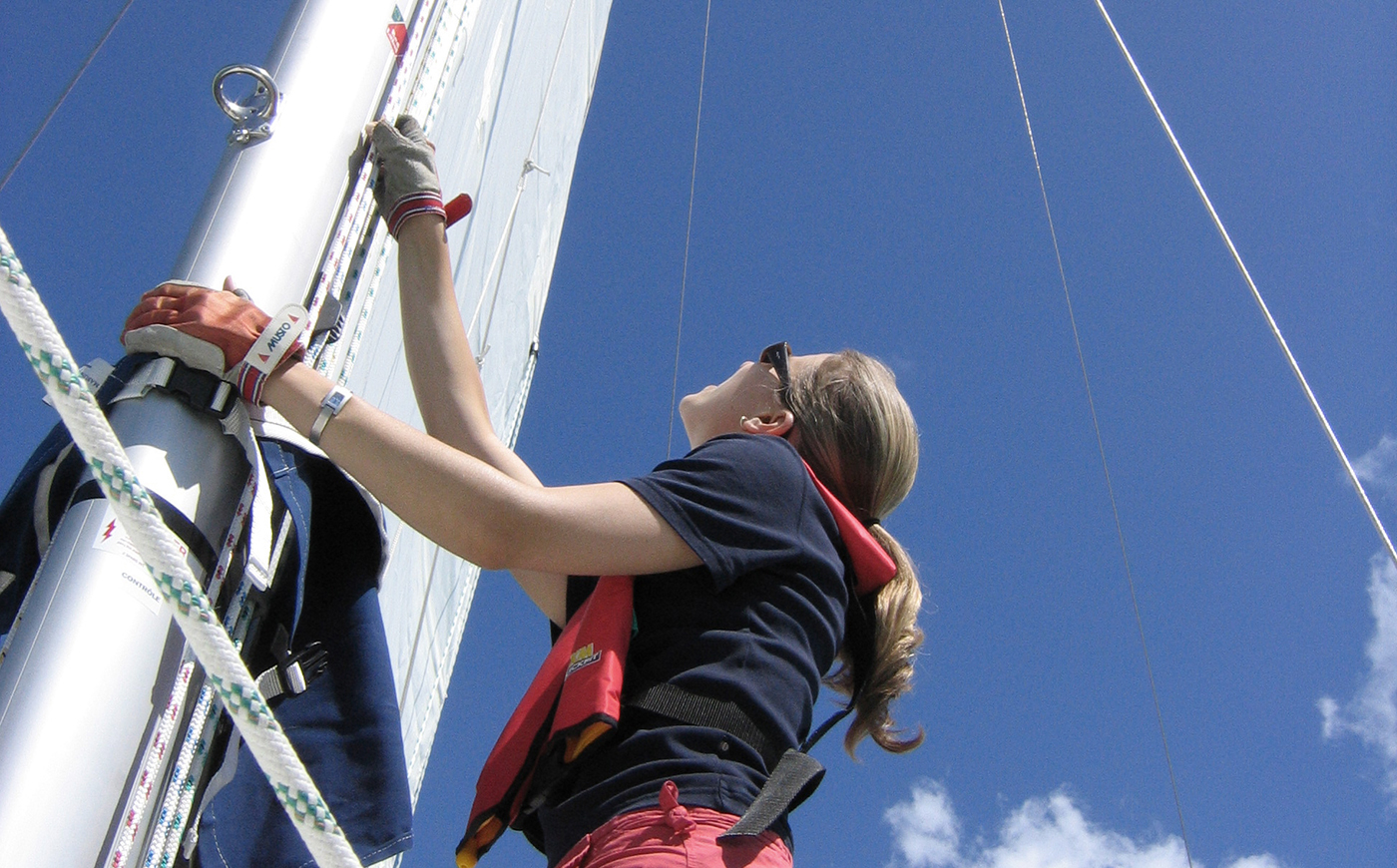
Every time you change sailing direction, even if it’s just for a short time, you'll need to trim your sails depending on your heading. As you turn toward the wind, this is called 'heading up' and you must pull your sails in, ‘sheeting in’. When you turn away from the wind, ‘bearing away’, you'll need to let the sails out, or ‘ease the sheets.’
Sailing Upwind
You can sail in any direction except directly into the wind, in the no go zone, about 40 degrees off the wind is about as close as you can get. So, if you want to sail upwind you need to zigzag from side to side of the no go zone. This is called beating to windward and involves tacking your boat through about 90 degrees from close hauled to close hauled through the no go zone.
For more information about identifying the different points of sail get your copy of RYA Start Sailing!
To further develop your sailing knowledge and skills take a look at our range of courses and get started with your adventures on the water.
Better Sailing
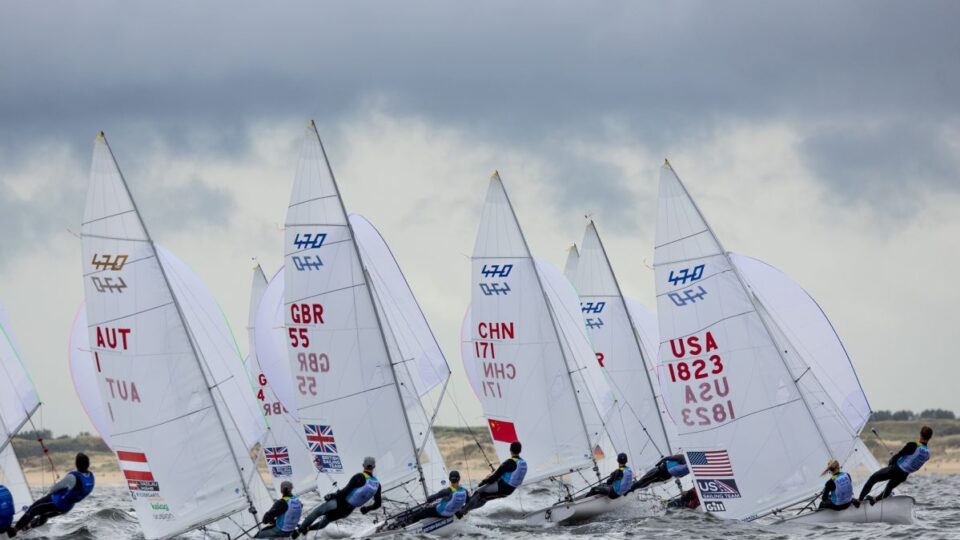
How Does Sailing Work? The Physics of Sailing
Sailing, with its graceful boats skimming across the water powered solely by the wind, is a captivating and ancient mode of transportation and recreation. While it might seem like magic, the principles behind sailing are firmly grounded in physics. The interplay between the wind, the water, and the structure of the sailboat creates an intricate dance of forces that propels the vessel forward. In this article, we will delve into the physics of sailing to uncover the mechanics behind this age-old practice.
The Role of the Wind: Lift and Drag
At the heart of sailing lies the wind – a dynamic force that fills the sails and provides the energy needed to move the boat. The interaction between the wind and the sail is based on the principles of lift and drag, which are also fundamental to aviation and other fluid dynamics.
When wind flows over the curved surface of a sail, it creates an area of lower pressure on the windward side and an area of higher pressure on the leeward side. This pressure difference generates lift, much like an airplane wing. The sail’s shape and angle in relation to the wind determine the amount of lift generated. By adjusting the sail’s angle, sailors can control the lift and subsequently the boat’s direction.
Drag, on the other hand, is the resistance the sail experiences due to the friction between the air molecules and the sail’s surface. While drag can’t be entirely eliminated, modern sail designs aim to minimize it to ensure the boat moves efficiently through the water.
>>Also Read: How Fast Can a Sailboat Go?
The Concept of Apparent Wind
In a straightforward scenario, a sailboat would travel directly downwind with the wind pushing the sails from behind. However, sailing often involves moving at angles to the wind, a concept that introduces the notion of apparent wind.
Apparent wind is the combination of the true wind – the wind blowing over the Earth’s surface – and the wind generated by the boat’s motion through the water. As the boat sails at an angle to the true wind, the wind experienced by the boat appears to come from a different direction and at a higher speed than the true wind. This apparent wind is crucial for maintaining lift on the sails, even when sailing against the true wind direction.

Points of Sail: Navigating the Wind Angles
To understand how sailboats maneuver, it’s essential to grasp the concept of points of sail. These are specific angles at which a boat can sail relative to the wind direction. The main points of sail are:
- Close-hauled: Sailing as closely as possible into the wind. This requires the sails to be trimmed in tightly, and the boat moves forward at an angle against the wind.
- Close reach: Sailing diagonally to the wind, between close-hauled and a beam reach.
- Beam reach: Sailing perpendicular to the wind. This is often the fastest point of sail as the boat can fully capture the wind’s energy.
- Broad reach: Sailing diagonally away from the wind, between a beam reach and running.
- Running: Sailing directly downwind, with the wind coming from behind the boat.
By adjusting the angle of the sails and the boat’s course, sailors can optimize their speed and direction according to the prevailing wind conditions.
>>Also Read: Points of Sail Explained
Balancing Forces: The Keel and Centerboard
While the wind provides the forward propulsion, the boat’s stability and ability to maintain a straight course are maintained through the use of a keel or centerboard, depending on the type of sailboat.
The keel is a heavy, fin-like structure located beneath the boat’s hull. It serves two main purposes: counteracting the force of the wind pushing the boat sideways (referred to as leeway) and providing ballast to keep the boat upright. The keel’s shape generates lift in the water that counters the lateral force of the wind, allowing the boat to sail closer to the wind without being pushed sideways.
For boats with a centerboard, which is a retractable fin located in the center of the boat, the principle is similar. By adjusting the centerboard’s depth, sailors can control the boat’s lateral resistance and stability.
>>Also Read: How do Sailboats Move Without Wind?
Tacking and Jibing: Changing Course with the Wind
Sailing isn’t just about going in a straight line – sailboats can change direction by tacking and jibing.
Tacking involves turning the boat’s bow through the wind so that the wind changes from one side of the boat to the other. This maneuver allows the boat to change direction while maintaining forward momentum. During a tack, the sails are let out to spill the wind’s energy, the bow crosses through the wind, and then the sails are trimmed in again on the new tack.
Jibing, on the other hand, is a maneuver where the stern of the boat crosses through the wind. This is often used when sailing downwind. Jibing requires careful coordination, as the sails can swing abruptly from one side to the other, potentially causing powerful forces.
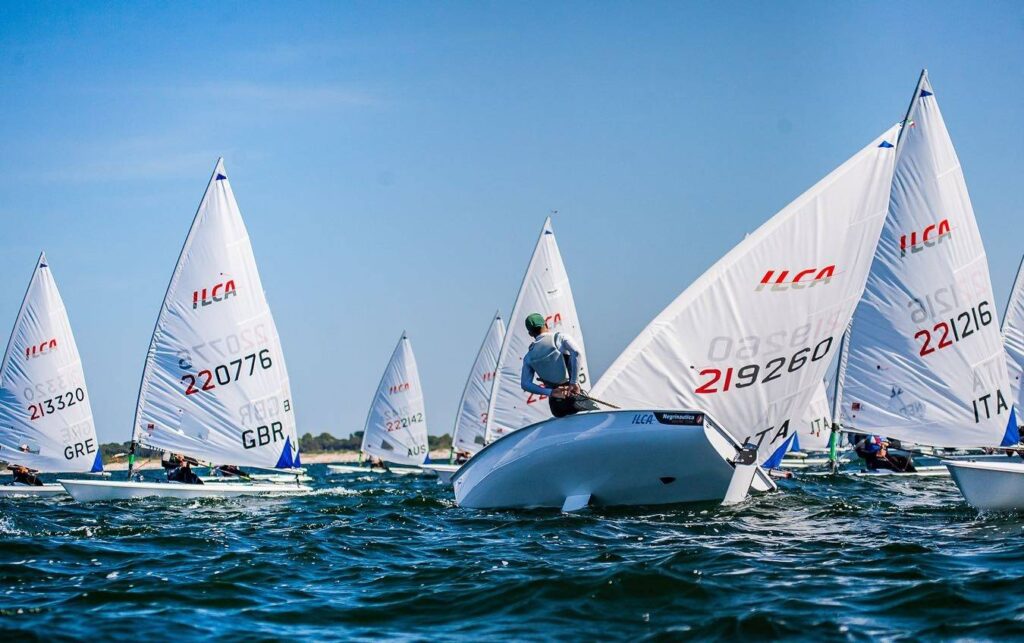
Sail Shape and Rigging: Aerodynamics of Sailing
The shape of the sail and the configuration of the rigging also play a vital role in the physics of sailing. Modern sail designs use a combination of materials and engineering to create sails that are both efficient and durable.
The angle at which the sail is set, known as the angle of attack, determines the amount of lift and drag produced. Sails are typically designed with a curved shape, known as camber, which allows for better lift generation and minimizes drag. Adjustable controls such as the cunningham, outhaul, and boom vang enable sailors to modify the shape of the sail according to wind conditions.
The mast, rigging, and other structural elements of the sailboat are designed to distribute forces evenly and provide stability. The tension in the rigging affects the shape of the mast, which, in turn, affects the shape of the sail. Balancing these factors ensures optimal sail performance and boat stability.
>>Also Read: Most Common Sailing Terms
How Does Sailing Work? The Physics of Sailing – In Conclusion
Sailing is a captivating interplay of physics and nature, where the wind’s energy is harnessed to propel a boat gracefully across the water. By understanding the principles of lift, drag, apparent wind, and the mechanics of sail shape and rigging, sailors can navigate the seas with precision and finesse. From the ancient mariners who first ventured out onto the open waters to the modern sailors competing in high-tech races, the physics of sailing remains a timeless and essential art.
Peter is the editor of Better Sailing. He has sailed for countless hours and has maintained his own boats and sailboats for years. After years of trial and error, he decided to start this website to share the knowledge.
Related Posts

Atlantic vs Pacific: Which is More Dangerous for Sailing?

Why Do Sailboats Lean?

How Does a Boat Sail Upwind? Unveiling the Mechanics of Against the Wind Sailing
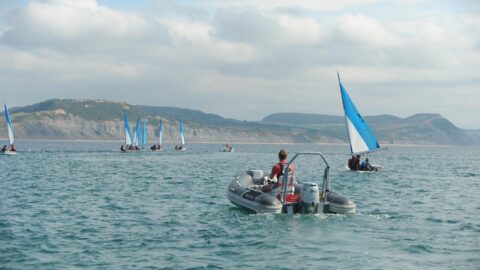
Best Sailing Certifications – Which Sailing Certification is Better?
- Buyer's Guide
- Destinations
- Maintenance
- Sailing Info
Hit enter to search or ESC to close.

Mastering the Art: Learn How to Sail a Sailboat with Expert Guidance
Alex Morgan
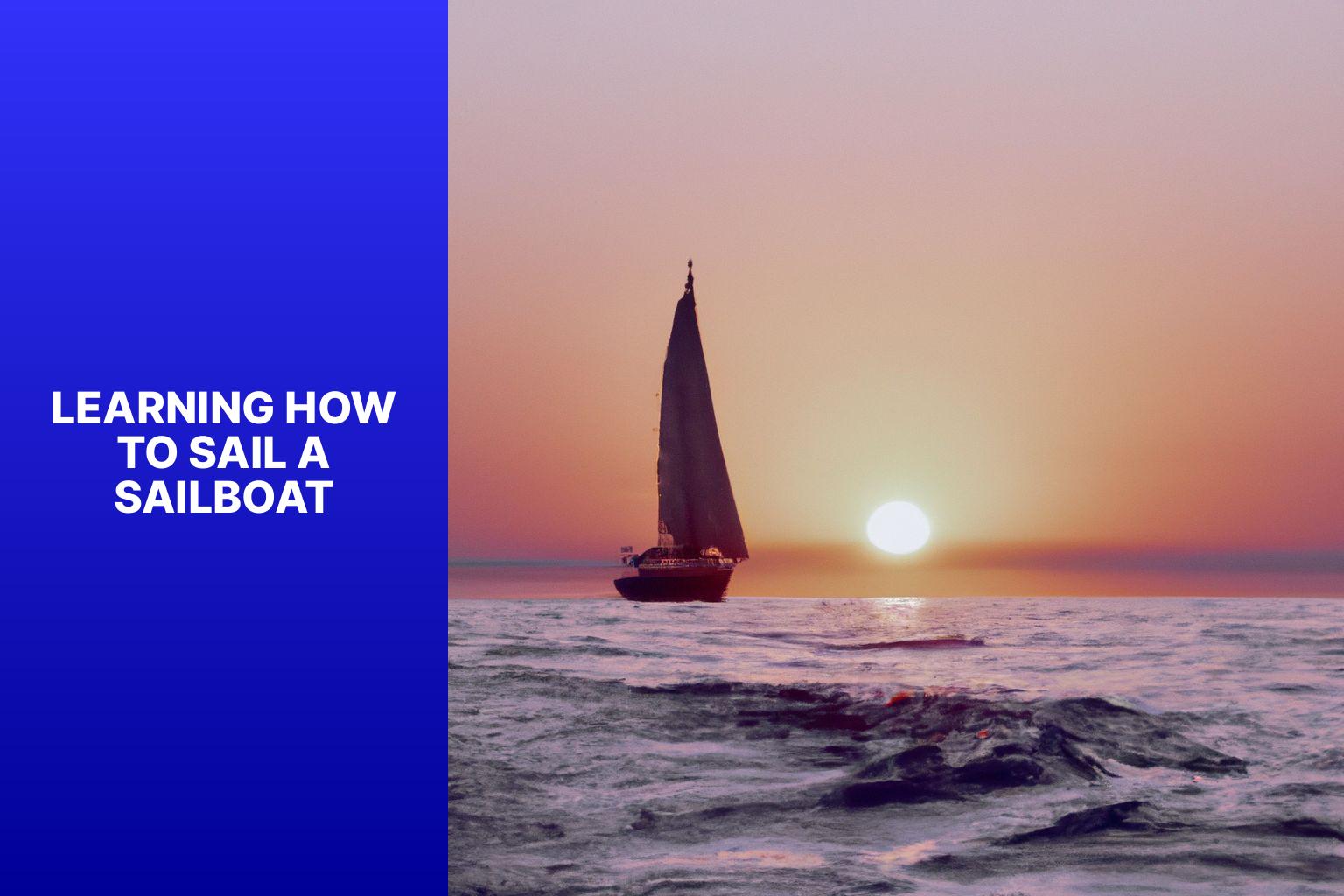
Sailing a sailboat is an exhilarating and rewarding experience that allows you to harness the power of the wind and navigate through the waters. Whether you’re a beginner or have some sailing experience, learning how to sail a sailboat is a valuable skill that opens up a world of adventure. In this article, we will explore the essential aspects of sailing and provide a step-by-step guide to get you started on your sailing journey.
Introduction to Sailing
To begin, we will introduce you to the world of sailing, discussing its basics, terminology, and the various types of sailboats available. Understanding the fundamentals of sailing is crucial to ensure a safe and enjoyable experience on the water.
Understanding the Basics of a Sailboat
We will delve into the different parts of a sailboat, including the mast, boom, sails, and rigging, explaining their functions and how they work together to harness the wind’s power. we will explore the different types of sailboats, such as dinghies, keelboats, and catamarans, highlighting their unique characteristics and uses.
Essential Skills and Techniques for Sailing
Mastering the essential skills and techniques for sailing is vital for a successful sailing voyage. We will cover topics such as wind awareness, sailing terminology, sail trim, points of sail, steering, and navigation. These skills form the foundation of sailing and will allow you to control the boat effectively and maneuver in various conditions.
Learning to Sail: Step-by-Step Guide
Taking a step-by-step approach, we will guide you through the process of learning to sail. We will discuss important safety precautions and equipment, boarding and leaving the dock, raising and lowering sails, tacking and jibing, and maneuvering and docking. Following this guide will help you gain confidence and develop the necessary skills to handle a sailboat with ease.
Improving Your Sailing Skills
Once you have grasped the basics, we will provide tips on how to improve your sailing skills. This includes practicing sailing techniques, understanding wind patterns and conditions, and considering options for taking sailing courses and lessons. Continuously honing your skills will enhance your sailing abilities and make each sailing excursion even more enjoyable.
Important Safety Tips for Sailing
We will emphasize the importance of safety while sailing. Sailing can present its challenges, so we will provide essential safety tips to keep you and your crew safe on the water. From wearing the right safety gear to being aware of weather conditions, these tips will ensure a secure and enjoyable sailing experience.
By the end of this article, you will have a comprehensive understanding of how to sail a sailboat, feel confident in your skills, and be ready to embark on your sailing adventures with knowledge and enthusiasm. So hoist your sails, catch the wind, and set sail towards exciting and unforgettable journeys on the water.
Key takeaway:
- Learning how to sail a sailboat maximizes adventure: Sailing experience allows individuals to explore the open water, enjoying the thrill of the wind and waves.
- Understanding the basics of a sailboat adds to safety: Familiarizing oneself with the parts of a sailboat and the different types of sailboats ensures safe and efficient navigation.
- Essential skills and techniques for sailing enhance performance: Developing knowledge in wind awareness, sail trim, points of sail, and navigation enables sailors to optimize their sailing experience.
Embark on an exciting journey as we dive into the world of sailing and unveil the basics of a sailboat. Discover the various components that make up a sailboat, and gain insights into the different types of sailboats out there. Whether you’re a seasoned sailor or a novice eager to learn, this section holds the key to understanding the fundamental aspects of sailing. So, fasten your life jackets and get ready to set sail into a world of knowledge and adventure !
Parts of a Sailboat
Hull: The main body of a sailboat provides buoyancy and supports all other components.
Mast: A tall vertical pole that supports the sails and stands upright on the boat.
Boom: A horizontal pole that extends from the mast and holds the foot of the mainsail.
Sails: These are large pieces of fabric that catch the wind and propel the sailboat forward. The sails include the mainsail, jib, and spinnaker.
Keel: This fin-like structure extends downward from the hull to provide stability and prevent capsizing.
Rudder: A vertical plate or blade at the back of the sailboat, controlled by the tiller or wheel, that steers the sailboat.
Tiller: This handle, attached to the rudder, allows the sailor to control the direction of the sailboat.
Winches: Mechanical devices used to control and adjust the tension of the sails and lines.
Lines/Ropes: These are used for various purposes such as raising and trimming sails, securing the boat, and controlling rigging.
Deck: The upper surface of the sailboat where sailors stand and various components are located.
Types of Sailboats
There are different types of sailboats, each with unique features and purposes. Here is a table that provides information about the different types:
These are just a few examples of sailboat types. The selection depends on preferences, uses, and experience level. Whether you want a comfortable cruising experience, the thrill of racing, or leisurely day trips, there is a sailboat suitable for every sailor.
Embark on a journey into the world of sailing as we dive into the essential skills and techniques needed to master the art of sailing. From wind awareness and sailing terminology to sail trim and adjustments, we’ll explore how to harness the power of the wind and optimize the performance of your sailboat. Get ready to navigate the points of sail and enhance your steering and navigation skills, all while feeling the exhilarating rush of the open waters.
Wind Awareness and Sailing Terminology
When sailing, having a keen sense of wind awareness and a solid understanding of sailing terminology are vital. Here are some key points to keep in mind:
1. Sail Trim: One must adjust the sails correctly to harness the maximum power of the wind and maintain control over the boat’s speed and direction. The sails should be trimmed by either tightening or loosening the attached sheets (lines).
2. Points of Sail: It is essential to sail at different angles relative to the wind. These angles include close-hauled (which is the closest to the wind), reaching (at an angle to the wind), and running (downwind).
3. Apparent Wind: As a sailor, it is crucial to feel the wind on the boat. This wind is a combination of the true wind and the wind generated by the boat’s movement. Understanding how the apparent wind changes while sailing is crucial for making necessary adjustments.
4. Tacking and Jibing: Changing the boat’s direction effectively involves turning the bow of the boat through the wind for tacking and the stern for jibing. These maneuvers take advantage of the wind to change the boat’s course successfully.
5. Sailing Terminology: It is important to familiarize yourself with various sailing terms. Terms like port (which refers to the left side of the boat facing the bow), starboard (which refers to the right side of the boat facing the bow), and luffing (sails flapping due to insufficient wind) are common and necessary to know.
Remember, possessing wind awareness and a solid grasp of sailing terminology are fundamental skills for becoming a skilled sailor. These abilities allow you to navigate and control the boat effectively, ensuring a safe and enjoyable sailing experience.
Fact: Sailors make use of wind indicators called telltales, small pieces of fabric attached to the sails, to gauge wind direction and optimize their sailing performance.
Sail Trim and Adjustments
When sailing, sail trim and adjustments optimize boat performance. Consider these factors:
- Sail tension: Properly tension sails for optimal performance. Adjust tension by tightening or loosening the halyard and/or sheet.
- Twist: Adjust the angle between the top and bottom of the sail to control power and balance.
- Shape: Cunninghams, outhauls, and boom vangs control sail shape based on wind conditions.
- Telltales: These small pieces of yarn or ribbon indicate correct sail trim. Ensure smooth airflow over the sail.
- Reefing: Reduce sail surface area in challenging conditions. Become familiar with the reefing system and practice reefing maneuvers.
Maximize speed, efficiency, and maneuverability by properly trimming and adjusting sails. Experiment, practice, and observe boat speed, wind direction, and balance for optimal performance.
Points of Sail
In sailing, understanding the points of sail is crucial for navigating different wind directions. When sailing close-hauled , the boat sails as close to the wind direction as possible, while on a beam reach , the wind comes from the side of the boat. The broad reach involves sailing with the wind coming from behind at an angle, while running means sailing directly downwind. Between close-hauled and beam reach, lies the close reach position, and between a beam reach and running comes the broad reach position. By knowing these different points of sail, sailors can adjust their sails and boat’s position to optimize speed and performance in various wind conditions.
Steering and Navigation
Steering and navigation are essential skills to acquire in sailing. When it comes to steering the sailboat effectively, it is crucial to understand wind direction and make adjustments accordingly.
One important aspect of navigation is the ability to read nautical charts and utilize navigational aids like buoys and markers. Using a compass or GPS can help determine the boat’s heading and navigate towards the desired destination.
Plotting a course and being flexible in adjusting it based on changing winds and currents is another key point in navigation. It is important to navigate around potential hazards such as rocks, sandbars, and other vessels, while also employing proper communication and signaling techniques.
Practicing various sailing techniques and adjusting the sail trim accordingly is essential for different conditions. Familiarity with right of way rules is crucial for safely navigating in crowded waterways or around other boats.
Continuous monitoring of weather conditions is necessary to make course adjustments for safety reasons. Having a backup plan for emergencies or unexpected changes in the navigation plan is always a wise precaution.
By honing your steering and navigation skills, you can confidently navigate your sailboat and fully enjoy the exhilarating experience of sailing.
Learning to sail a sailboat can be an exhilarating adventure ! In this step-by-step guide , we’ll cover everything you need to know to set sail with confidence . From essential safety precautions and equipment to the art of maneuvering and docking , each sub-section will bring you closer to mastering the art of sailing . So grab your life jacket , hop aboard, and let’s embark on this exciting journey together!
Safety Precautions and Equipment
When sailing, it is crucial to prioritize safety. It is important to consider and have the following safety precautions and equipment on board:
1. Life jackets: Ensure that everyone on board wears properly fitting life jackets, especially when navigating through rough waters.
2. Navigation tools: Equip your sailboat with a compass, charts, and a GPS to stay on course and navigate effectively.
3. First aid kit: Stock your sailboat with a well-equipped first aid kit to handle any medical emergencies that may arise.
4. Communication devices: Carry a VHF radio or a mobile phone with a waterproof case to effectively communicate with the shore or other vessels.
5. Emergency flares: Keep distress flares on board to signal for help if the need arises.
6. Fire extinguisher: Have a working fire extinguisher readily available to deal with any onboard fires that may occur.
7. Safety harnesses and tethers: Utilize safety harnesses and tethers to secure yourself to the boat and prevent any accidental falls or overboard incidents.
8. Anchor and anchor line: Always ensure that you have a reliable anchor and an adequate length of anchor line to secure your sailboat when necessary.
It is important to familiarize yourself with all the safety equipment on your sailboat and know how to use it properly. Regular maintenance and inspections are essential to ensure that everything functions correctly. Always prioritize safety and enjoy your sailing adventures!
Boarding and Leaving the Dock
When boarding and leaving the dock on a sailboat, follow these steps for a safe and successful departure or arrival.
- Check the dock lines: Ensure the dock lines are properly secured and won’t get tangled or caught when leaving.
- Prepare the fenders: Attach fenders to the sides of the boat to protect it from damage as you leave the dock.
- Notify the crew: Inform your crew members that you’re about to leave the dock and they should be ready to assist.
- Untie the lines: Carefully release the dock lines one at a time and ensure the boat remains secure.
- Use the engine: Start the engine and use it to maneuver away from the dock cautiously.
- Steer away: Once you’ve moved away from the dock, steer the boat in the desired direction.
The practice of boarding and leaving the dock has been essential to sailing for centuries. Ancient sailors used various techniques to navigate harbors safely. While technology has evolved, the principles remain the same. Sailors rely on their skills and knowledge to maneuver sailboats with precision and confidence . By following proper procedures, sailors can ensure smooth starts and ends to their sailing adventures.
Raising and Lowering Sails
To successfully raise and lower sails on a sailboat, it is important to follow these steps while incorporating the keywords naturally:
- Begin by preparing the sails appropriately, ensuring they are folded and stowed properly. Take the time to check for any damage or signs of wear to guarantee their functionality.
- Attach the halyards securely. The halyards are crucial in both raising and lowering the sails, so fasten them tightly to prevent any mishaps.
- Hoist the sail using a smooth and steady motion until it reaches its full height. It is crucial to pay attention to its alignment and tension to ensure optimal performance.
- Once the sail is fully raised, make sure to secure it in place with a secure knot or by using a cleat. This will prevent any sudden movements or accidents while sailing.
- For desired shape and position adjustments, utilize sail controls such as sheets and trim lines. These controls will help you achieve the perfect configuration for optimal sailing.
- Gradually lower the sails by releasing tension on the halyards, all the while remaining cautious of any sudden gusts of wind. Accidents can be avoided by maintaining awareness of the surroundings.
- After fully lowering the sails, secure the halyards again and make sure to coil and stow them neatly. This will prevent any entanglements or damage during storage.
Always prioritize safety and be aware of your surroundings when handling sails. Ensure that all crew members are clear of the sail and rigging to avoid any potential accidents. Regularly practicing these steps will help you become proficient in sailboat sail handling.
Tacking and Jibing
Tacking and jibing are important maneuvers in sailing to change the sailboat’s direction. Here is a step-by-step guide on performing tacking and jibing:
Assess wind direction and determine if a tack change is needed.
Steer the boat towards the wind until it is approximately 45 degrees off the bow.
Release the jib or genoa sheet and let it flap in the wind while turning.
As the bow passes through the wind, quickly pull in the jib or genoa sheet on the opposite side to fill the sail.
Trim the mainsail and adjust the boat’s course as necessary.
Determine if a jibe is necessary based on wind direction.
Steer the boat away from the wind until it is approximately 135 degrees off the bow.
Ease out the mainsail as you turn to allow it to swing across the stern.
As the mainsail crosses to the opposite side, quickly adjust the mainsheet to trim the sail on the new side.
Steer the boat on the new course and adjust the jib or genoa sheet as needed.
Remember to communicate with your crew members and be aware of other boats nearby when tacking or jibing. Practice these maneuvers regularly to enhance your sailing skills and improve proficiency on the water.
Maneuvering and Docking
Maneuvering and docking a sailboat requires skill and technique to ensure a smooth and safe experience. Here are the steps to effectively maneuver and dock a sailboat:
1. Approach the dock at a controlled speed with enough momentum to reach the desired position.
2. Plan your approach based on wind direction , current , and any obstacles or other boats in the area.
3. Communicate with your crew members to prepare them for the docking procedure.
4. As you near the dock, prepare your fenders and dock lines to secure the boat.
5. Gradually reduce your speed while maintaining control of the boat.
6. Use your sails , engine , and rudder to make small adjustments in your course and position.
7. Aim to approach the dock at a slight angle for better control over the boat’s movements.
8. Coordinate with your crew to toss the dock lines onto the dock and secure them properly .
9. Slowly bring the boat alongside the dock, allowing the crew to step off and secure the boat.
10. Once the boat is securely docked , turn off the engine and adjust the sails.
Remember, practice is key when maneuvering and docking a sailboat. With experience, you will become more confident in your abilities.
Become a skilled sailor by honing your sailing abilities in various ways. From practicing sailing techniques to understanding wind patterns and conditions, and even taking professional sailing courses and lessons , this section will delve into the different aspects of improving your sailing skills. Get ready to set sail on a journey of knowledge and mastery that will empower you to navigate the waters with confidence and expertise .
Practicing Sailing Techniques
Practicing sailing techniques is crucial for skilled sailors. Here is a comprehensive guide to help you enhance your sailing abilities:
1. Start by mastering basic maneuvers: Dedicate time to practicing tacking and jibing to effectively change direction while sailing.
2. Focus on sail trim: Make adjustments to the sails to optimize their position and shape, ensuring maximum efficiency.
3. Hone your skills in different points of sail: Learn to navigate effectively at various angles to the wind, mastering the art of sailing in all directions.
4. Enhance your boat handling abilities: Develop the expertise to control the boat proficiently in different weather and water conditions.
5. Improve your wind awareness: Pay close attention to wind patterns and fluctuations, enabling you to make effective sailing decisions.
To advance your sailing skills further, it is highly recommended to consider enrolling in sailing courses or taking lessons from experienced instructors. They can offer invaluable guidance and additional techniques for you to practice. Remember, practice makes perfect! Therefore, make it a priority to spend as much time as possible on the water, continuously honing and refining your skills.
Understanding Wind Patterns and Conditions
Understanding wind patterns and conditions is essential for successful sailing. Active observation and analysis of the wind can have a significant impact on a sailor’s performance. It is crucial to comprehend how wind direction, speed, and shifts can influence a sailboat.
When sailing downwind, with the wind coming from behind, it allows for faster speeds. When sailing upwind, zigzagging maneuvers are necessary to make progress. Properly adjusting the sails based on wind conditions will maximize propulsion.
A comprehensive understanding of wind patterns helps sailors anticipate changes and make strategic decisions. The observation of ripples or waves on the water’s surface can indicate shifts or gusts. Familiarity with the local wind patterns specific to the sailing area can provide a competitive advantage.
Sailors must also take into consideration other factors that can affect wind patterns, such as land masses or obstacles. Mountains , buildings , and geographical features can create wind shadows or accelerations that need to be considered.
By understanding wind patterns and conditions, sailors can make informed decisions to optimize their sailing experience and enhance their overall performance on the water.
Taking Sailing Courses and Lessons
Taking sailing courses and lessons can greatly enhance your sailing skills. These courses provide structured instruction and guidance from experienced instructors who teach techniques and safety precautions for sailing. By enrolling in these courses, you have the opportunity to learn valuable skills such as maneuvering the sailboat, understanding wind patterns, and navigating effectively.
Sailing courses and lessons offer a hands-on learning experience, allowing you to practice sailing techniques in real-life situations. It is highly recommended to research and choose reputable sailing schools or organizations that offer certified courses. These courses cover theory, practical exercises, and provide valuable hands-on training. Upon completion, certifications may be provided, which can be beneficial for employment or participation in sailing events.
Whether you are a beginner or an experienced sailor, taking sailing courses and lessons provides invaluable learning opportunities and helps you grow as a sailor. Consider enrolling in these courses to boost your sailing skills and cultivate a deeper understanding of sailing.
Remember, practice makes perfect, so continue to practice and refine your skills even after completing the courses. With time and dedication, you can become a proficient and confident sailor.
Always remember these important safety tips for sailing. First and foremost, always wear a life jacket while sailing to prioritize your safety.
Ensure to check the weather conditions beforehand to avoid any unexpected storms or strong winds that could jeopardize your journey.
Before setting sail, it is crucial to inspect your boat thoroughly for any signs of damage or mechanical issues that may occur during your trip.
Inform someone trustworthy about your sailing plans and provide them with an estimated return time in case of any emergencies.
Stay vigilant of other boats and objects in the water to prevent any collisions or accidents.
Follow proper navigation techniques and abide by maritime rules and regulations to ensure a smooth and secure sailing experience.
It is also essential to have an emergency safety plan in place and familiarize yourself with the usage of communication devices in case of any unforeseen circumstances.
Take care of yourself by staying hydrated and protecting your skin from the harmful sun rays with sunscreen and a hat .
Avoid consuming alcohol while sailing as it impairs judgement and coordination, increasing the risk of accidents.
Regularly check and maintain your safety equipment, including fire extinguishers and first aid kits, to ensure they are in good working condition.
By incorporating these important safety tips into your sailing routine, you can enjoy a safer and more enjoyable experience on the water.
Some Facts About Learning How To Sail A Sailboat:
- ✅ Learning to sail involves specific knowledge, honed skills, and a gut instinct for the wind and the feel of the boat.
- ✅ Familiarizing oneself with sailing vocabulary, including terms like port, starboard, leeward, halyard, and tacking, is crucial for beginners.
- ✅ Understanding the points of sail is crucial as it determines the directions a sailboat can maneuver and the corresponding sail positions.
- ✅ Knowing the different parts of a boat, such as vang, downhaul, mizzen, and centerboard, is important for beginners.
- ✅ Knot tying is an essential skill for sailors as there are many lines on a boat that require different knots.
Frequently Asked Questions
1. what are the basic sailing skills beginners should learn.
Beginners learning how to sail should start by familiarizing themselves with sailing vocabulary, understanding the points of sail, and learning the different parts of a boat. They should also practice knot tying, understand sail trim, and learn the rules of the road to sail safely.
2. What are some popular destinations to learn how to sail?
Some popular destinations for learning how to sail include the Gulf of Mexico, the British Virgin Islands, the Great Lakes, the Chesapeake Bay, and other places with nice resorts and marinas. These locations offer ideal settings for beginners to practice their sailing skills.
3. What type and size of boat is recommended for beginners to learn how to sail?
It is recommended for beginners to learn how to sail on keelboats like the Colgate 26. These boats provide stability and safety, making it easier for beginners to develop their sailing skills and confidence on the water.
4. How can I find a reputable sailing school to learn how to sail?
When looking for a sailing school, it is advisable to seek recommendations from others with experience. Word of mouth is a good source of information about reputable schools. It is also important to check if the instructors are certified and if the school offers a comprehensive package that fits your goals.
5. What is the best time of year to learn how to sail?
The best time to learn how to sail depends on your location, but spring and fall usually have the best winds for learning. It’s important to consider the local weather patterns and seasons to ensure optimal conditions for practicing and developing your sailing skills.
6. What are some essential items to bring when learning how to sail?
When learning how to sail, it is important to bring a waterproof jacket, sun lotion, a wide-brim hat, nonskid sneakers, and any other appropriate clothing and accessories to protect yourself from the elements. Also, it is advisable to carry a float plan and any necessary equipment recommended by the sailing school or instructor.
About the author
Leave a Reply Cancel reply
Your email address will not be published. Required fields are marked *
Save my name, email, and website in this browser for the next time I comment.
Latest posts

The history of sailing – from ancient times to modern adventures
History of Sailing Sailing is a time-honored tradition that has evolved over millennia, from its humble beginnings as a means of transportation to a beloved modern-day recreational activity. The history of sailing is a fascinating journey that spans cultures and centuries, rich in innovation and adventure. In this article, we’ll explore the remarkable evolution of…

Sailing Solo: Adventures and Challenges of Single-Handed Sailing
Solo Sailing Sailing has always been a pursuit of freedom, adventure, and self-discovery. While sailing with a crew is a fantastic experience, there’s a unique allure to sailing solo – just you, the wind, and the open sea. Single-handed sailing, as it’s often called, is a journey of self-reliance, resilience, and the ultimate test of…

Sustainable Sailing: Eco-Friendly Practices on the boat
Eco Friendly Sailing Sailing is an exhilarating and timeless way to explore the beauty of the open water, but it’s important to remember that our oceans and environment need our protection. Sustainable sailing, which involves eco-friendly practices and mindful decision-making, allows sailors to enjoy their adventures while minimizing their impact on the environment. In this…

The Ultimate Guide to Choosing Between a Sailboat or Catamaran for Your Sailing Adventures
C hoosing between a sailboat and a catamaran for your sailing adventures is a significant decision that depends on various factors, including your sailing preferences, experience level, budget, and intended use. Here's an ultimate guide to help you make an informed decision:
1. Sailing Experience:
- Sailboats: Typically require more skill and experience to handle, especially in adverse weather conditions. Ideal for sailors who enjoy the traditional feel of sailing and are willing to invest time in learning and mastering the art.
- Catamarans: Easier to handle, making them suitable for beginners. The dual-hull design provides stability, reducing the learning curve for those new to sailing.
2. Space and Comfort:
- Sailboats: Generally have a narrower beam and less living space. However, some sailboats may offer comfortable cabins and amenities.
- Catamarans: Wider beam creates more living space. Catamarans often have multiple cabins, spacious saloons, and expansive deck areas, providing a more comfortable living experience.
3. Stability:
- Sailboats: Monohulls can heel (lean) while sailing, which some sailors enjoy for the thrill but can be discomforting for others.
- Catamarans: Greater stability due to the dual hulls, providing a more level sailing experience. Reduced heeling makes catamarans suitable for those prone to seasickness.
4. Performance:
- Sailboats: Known for their upwind performance and ability to sail close to the wind. Some sailors appreciate the challenge of optimizing sail trim for efficiency.
- Catamarans: Faster on a reach and downwind due to their wide beam. However, they may not point as high into the wind as monohulls.
- Sailboats: Typically have a deeper draft, limiting access to shallow anchorages and requiring deeper marina berths.
- Catamarans: Shallow draft allows access to shallower waters and secluded anchorages, providing more flexibility in cruising destinations.
- Sailboats: Generally more affordable upfront, with a wide range of options available to fit different budgets.
- Catamarans: Often more expensive upfront due to their size and design. However, maintenance costs may be comparable or even lower in some cases.
7. Mooring and Docking:
- Sailboats: Easier to find slips and moorings in marinas designed for monohulls.
- Catamarans: Require wider slips and may have limited availability in certain marinas, especially in crowded anchorages.
8. Intended Use:
- Sailboats: Ideal for traditional sailors who enjoy the art of sailing, racing enthusiasts, or those on a tighter budget.
- Catamarans: Suited for those prioritizing comfort, stability, and spacious living areas, especially for long-term cruising and chartering.
9. Resale Value:
- Sailboats: Generally have a more established resale market, with a wider range of buyers.
- Catamarans: Growing in popularity, and well-maintained catamarans often retain their value.
10. Personal Preference:
- Consider your personal preferences, the type of sailing you plan to do, and the kind of lifestyle you want aboard your vessel.
In conclusion, both sailboats and catamarans have their advantages and disadvantages. Your decision should be based on your individual preferences, experience level, budget, and intended use. If possible, charter both types of vessels to experience firsthand how they handle and to help make a more informed decision based on your own preferences and needs.
The post The Ultimate Guide to Choosing Between a Sailboat or Catamaran for Your Sailing Adventures appeared first on Things That Make People Go Aww .

These 3 lesser-known cruise lines offer amazing voyages on sail-powered ships

There is nothing quite as magical — or romantic — as a cruise on a sailing ship.
To stand on the deck of a vessel topped with dozens of billowing sails, propelled through the waves by the power of the wind alone, is to go back in time to an earlier age of travel, when crossing the world's oceans was as adventurous as it was challenging.
It's an experience that's all about the feeling of the wind in your hair, the lean of the vessel (known as the heel) as it's pushed by the wind and the sway from the waves (which is actually smoother than what you get on a motor ship).
For more cruise guides, news and tips, sign up for TPG's cruise newsletter .
In contrast to what you'll find on so many motor-powered ships, cruising on a masted ship is about the simple thrill of traveling across the sea and not about all the many attractions you'll find on board.
Only a handful of small cruise brands — so small that you might never have heard of them — offer trips on sailing ships. Here, we look at the three biggest players in this niche subset of the cruise industry.
Sea Cloud Cruises

If it's an authentic, old-style sailing experience you want, then Sea Cloud Cruises is the line for you. The Germany-based company operates three large sailing ships where the sails are unfurled by hand, just as they were on sailing ships centuries ago.
On the biggest of these three vessels, the 136-passenger Sea Cloud Spirit , 18 deckhands scurry high into the rigging on sea days to manually untie and prepare the sails, an amazing sight. Unveiled in 2021 , it's a full-rigged, three-masted sailing ship of the sort that hasn't been common on the world's oceans for more than a century.
Related: Why Sea Cloud Spirit is a sailing vessel you'll want to try
Sea Cloud Cruises' two other vessels — Sea Cloud 2 and Sea Cloud — are smaller but offer a similar show as the sails are set by hand the old-fashioned way. The former is a 23-year-old, three-masted barque propelled by 23 sails (five fewer than Sea Cloud Spirit); the latter is a 93-year-old, four-masted barque with 30 sails and a storied past.
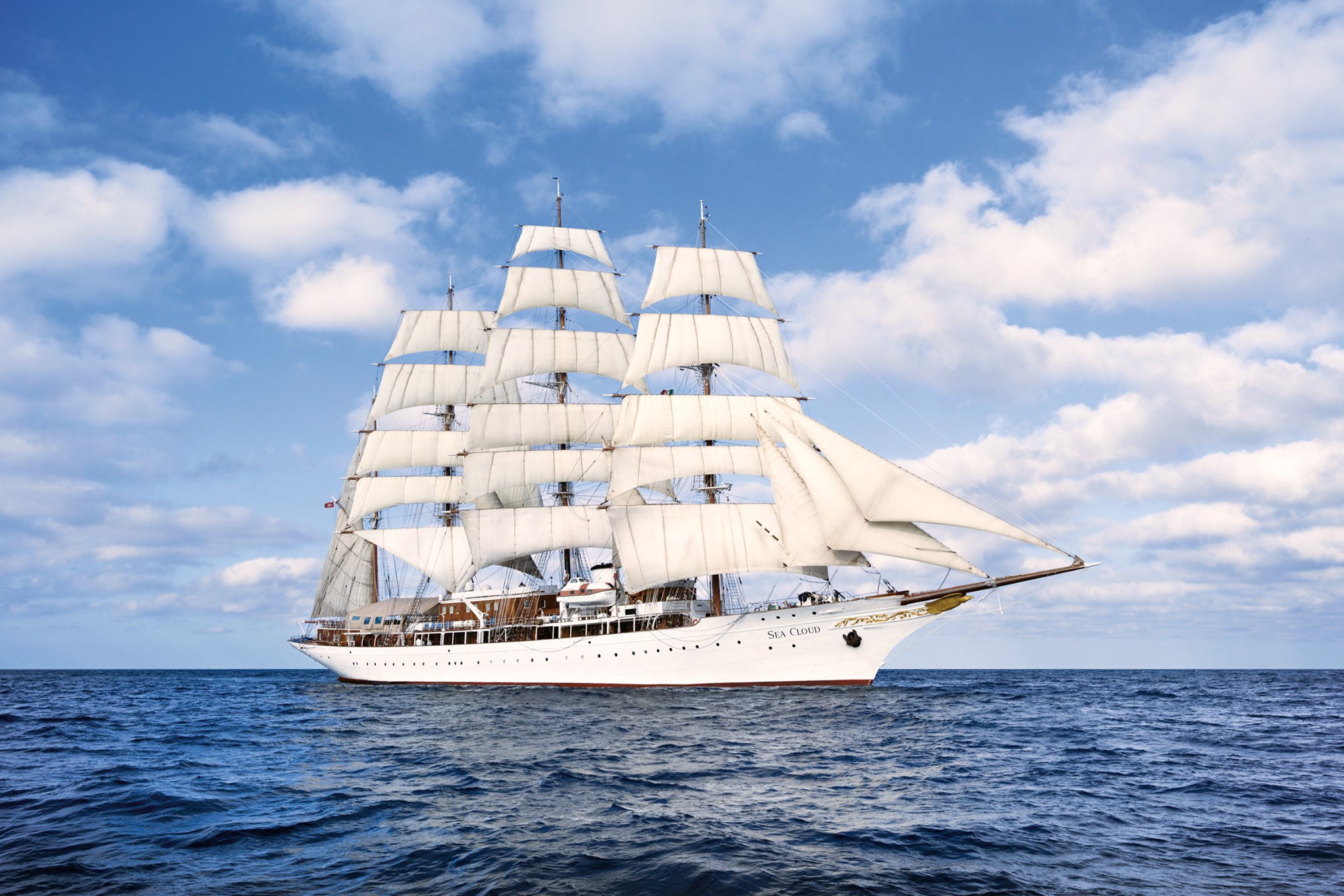
Now configured to carry 64 paying passengers, Sea Cloud was originally the private yacht of Postum Cereals heiress Marjorie Merriweather Post and her husband, the famed financier E. F. Hutton. At the time, the vessel was the largest private yacht in the world. It later served the U.S. Navy as a weather ship during World War II, after which it became the presidential yacht for the Dominican Republic. It only began sailing as a cruise vessel in the 1980s.
If you have money to spare, you can still book Post's opulent private quarters on Sea Cloud, now its owner's suite. It'll set you back around $5,000 per day per couple. Her husband's slightly smaller quarters are also available to book at a similar rate.
Post, the wealthiest woman in the U.S. during her lifetime, notably also built Mar-a-Lago, the massive estate in Florida that is now the official residence of Donald Trump.
Sea Cloud Cruises is the most all-inclusive and upscale of the three brands listed in this story, with pricing to match. Expect to pay nearly $1,000 per person per day or more for many sailings.
Sea Cloud Cruises' three vessels offer a diverse array of sailings in the Mediterranean, Northern Europe, the Canary Islands and Morocco, the Caribbean or along the west coast of Central America.
Related: Cruising Costa Rica, Panama with Sea Cloud Cruises
Windstar Cruises

Founded in the 1980s, Windstar Cruises got its start as a sailing ship line. While it now operates traditional motor-powered ships, too, voyages on sailing ships are still a big part of its business.
Three of the Seattle-based brand's six vessels — Wind Spirit, Wind Star and Wind Surf — are sailing vessels, and they all offer a similar yacht-like, small-ship experience.
Two of the three vessels (Wind Spirit and Wind Star) are particularly intimate, measuring 5,407 tons and carrying just 148 passengers with every berth full.
Related: The 2 types of Windstar ships, explained
The line's third sailing vessel, Wind Surf, is nearly three times the size at 14,745 tons. It's one of the biggest sailing ships in the world (only a sister vessel that sails for Club Med is bigger). Wind Surf carries 342 people, an enormous number for a sailing ship.
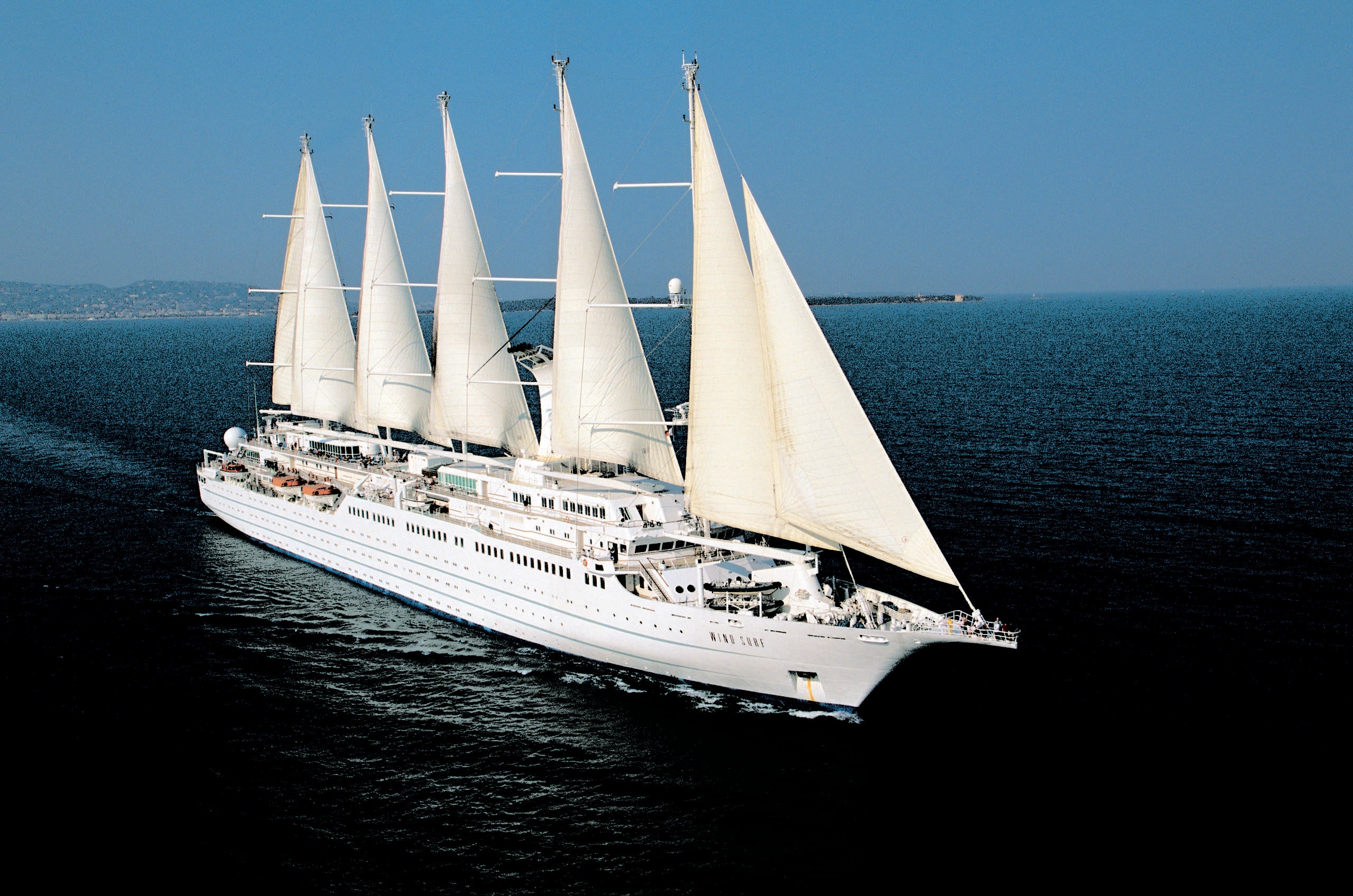
Unlike on the vessels operated by Sea Cloud, the sails on Windstar's sailing ships aren't unfurled by hand in the old-fashioned way but by the push of a button from the bridge. It's a fully automated system that is much more modern, if less dramatic.
Still, the experience of slicing through the waves by the power of the wind alone on Windstar ships is as glorious and romantic as it is on the Sea Cloud ships.
Windstar Cruises is less all-inclusive and pricey than Sea Cloud but still offers a relatively upscale experience. Its dining program is done in partnership with the food-focused James Beard Foundation, which also brings James Beard Award-winning chefs to the ships regularly for food-themed itineraries.
For an extra $89 per person per day, passengers can also make the experience more all-inclusive with included Wi-Fi, unlimited beer, wine and cocktails, and gratuities (three things that aren't included in regular fares).
The line's three vessels typically spend nearly all of their time sailing in the Mediterranean, the Caribbean or along the west coast of Central America.
Related: Read more about Windstar's itineraries
Star Clippers

Like Sea Cloud and Windstar, Star Clippers operates three sailing vessels that are among the biggest and most elegant sailing vessels in the world.
The belle of the ball at the line is Royal Clipper, a stunning five-masted ship that is billed as the largest square-rigged ship in the world. Its enormous array of 42 sails has a sail area of 56,000 square feet — significantly more than the sails atop any of the Sea Cloud or Windstar vessels. (Only Sea Cloud Spirit comes relatively close with a sail area of 44,100 square feet spread across 28 sails.)
Built to resemble Preussen, a legendary tall ship of the 19th century, the 24-year-old Royal Clipper shares the spotlight at Star Clippers with two smaller sister vessels, Star Flyer and Star Clipper.
Carrying 166 passengers apiece, the smaller vessels were designed to resemble the speedy clipper ships of the 19th century, which were known for their narrow profile and large sail area. Each vessel has a sail area of 36,000 square feet spread across 16 sails, a large amount for the size.
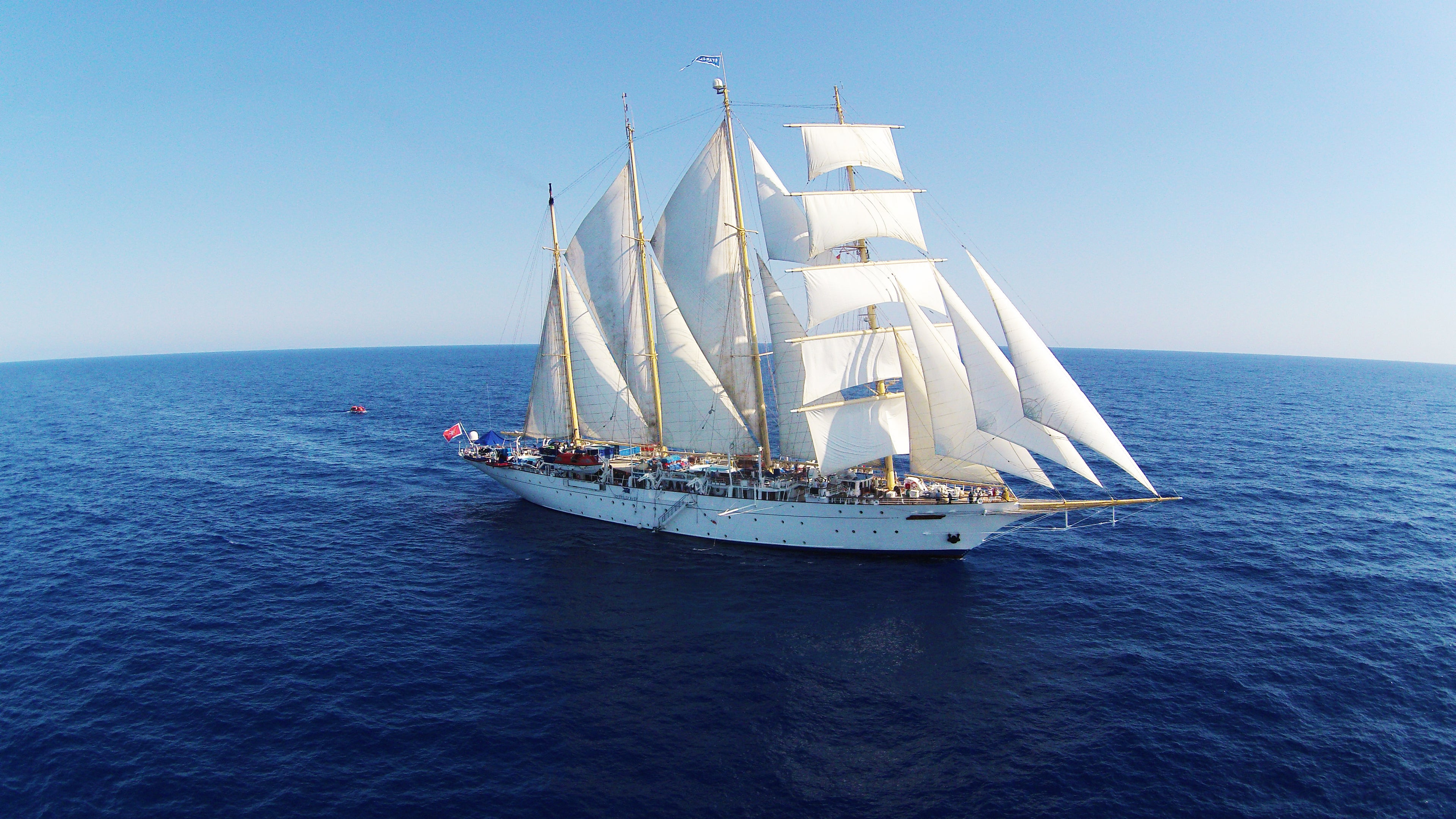
When it comes to the setting of sails, Star Clippers vessels offer a level of old-style authenticity that is in between the ships of Sea Cloud and Windstar. Like on Sea Cloud vessels, the sails are pulled into position by a team of deckhands using hand power and winches to tighten the "sheets," or ropes.
Unlike on Sea Cloud vessels, the deck hands don't climb high into the rigging to untie and prepare the sails for winching. That part is done automatically at the push of a button from the bridge, as it is on Windstar vessels.
In one key difference, though, Star Clippers lets passengers harness up and climb into the crow's nest of its vessels — a thrilling experience. Just be prepared for your knees to go a bit wobbly as you get to the top; it's way up there.
Star Clippers sailings are the most affordable option among the three sailing brands, in part because the onboard experience is less all-inclusive and upscale.
The three Star Clippers vessels mostly operate sailings in the Mediterranean, the Canary Islands, the Caribbean and along the west coast of Central America.
Bottom line
It's still possible to get a taste of what traveling the world's oceans was like in the days before motor power. Three small cruise companies — Sea Cloud Cruises, Windstar Cruises and Star Clippers — offer voyages on large sailing ships that are as majestic as anything that has sailed the seas in centuries past.
Planning a cruise? Start with these stories:
- The 5 most desirable cabin locations on any cruise ship
- A beginners guide to picking a cruise line
- The 8 worst cabin locations on any cruise ship
- The ultimate guide to what to pack for a cruise
- A quick guide to the most popular cruise lines
- 21 tips and tricks that will make your cruise go smoothly
- Top ways cruisers waste money
- The ultimate guide to choosing a cruise ship cabin
6 ultimate island-hopping itineraries for 2024
Explore the world from the deck of your own yacht with a skippered charter, bareboat or flotilla holiday. Whether you’re a first-timer, a foodie or a family, there’s a sailing itinerary to suit every type of traveller.

Craving a holiday with the freedom to escape the crowds and explore hidden coves, secluded bays and uninhabited islands? Dreaming of anchoring somewhere to take a dip without another person in sight? Sailing enables you to access remote spots that are often inaccessible by land and to experience the diversity of a region, exploring islands, villages and resorts in a single trip. Whether you're just starting out, or keen to set out with little ones in tow, these itineraries suit every type of sailor.
1. Best for first timers: British Virgin Islands (BVIs)
Calm seas, sheltered anchorages, reliable steady trade winds and easy line-of-sight sailing make the BVIs one of the world’s best sailing destinations for less experienced sailors. The proximity of its islands also means you only need to sail for an hour or two to gain a sense of adventure and achievement as you successfully navigate to the next port of call. Set sail in Tortola and continue on to Virgin Gorda to witness The Baths, a geological wonder made up of granite boulders that stretch down the beach into the sea. Look out for hawksbill turtles as you sail on to tiny specks of land such as the idyllic Saba Rock, and be sure to end the day with a rum cocktail or two at one of the region’s many laid-back bars, which are often perched on unblemished stretches of white sand.

2. Best for families: Croatia
The calm, clear waters of the Adriatic combined with favourable weather conditions in summer provide easy sailing for families and, with more than 1,000 islands dotted along the Dalmatian Coast, there’s a range of activities and attractions with short hops to keep kids engaged. Set sail from the picturesque marina village of Agana and cruise gently to islands such as Brač, Šolta and Hvar, encouraging children to help out on board while keeping an eye out for passing dolphins. With their sheltered bays and clear waters, these islands are ideal stops for families. Spend an afternoon paddling in Brač’s Bobovišća Bay, before setting sail for the remote islands of the Kornati Archipelago, a wild and beautiful national park known for its empty hiking trails. Sailing stops here can be educational, too, with a plethora of UNESCO World Heritage Sites and picturesque port towns steeped in history.
3. Best for food-lovers: Italy
Why base yourself on land to sample Italy’s incredible gastronomy when you can sail from region to region tasting the very best food and wine at numerous ports of call? Sunsail’s SailEatalia’s Italian Cuisine Procida Flotilla departs from the glamourous port town of Procida and sails to the Pontine Islands along the sun-soaked Amalfi Coast, offering stops to taste local cuisine, from classic dishes to regional delicacies as well as the country’s finest wine. Sample Ischia's iconic stewed rabbit in an independent restaurant at the top of a mountain or try the Italian coastal delicacy alici da portare (pasta with anchovies, olives and capers) in the quaint fishing village of Cetara.

4. Best for winter sun: Antigua
Gloriously warm weather between December and May and around 365 powdery white beaches lapped by clear waters make Antigua a popular winter sun destination for British travellers. Sailors can also relax knowing the region has consistent trade winds, safe anchorages and fairly short distances between ports, giving you more time to explore a variety of attractions at your own pace. Drop anchor in Deep Bay to snorkel around the famous shipwreck the Andes , discover uninhabited islands and visit famous places like Nelson’s Dockyard to sip cocktails and dance to the lively music of traditional steel bands.
5. Best for culture vultures: Croatia
A cultural treasure trove with 10 UNESCO World Heritage Sites ranging from Roman fortresses to hilltop castles, Croatia is a mecca for sailors with a penchant for history and art. Start and finish a week’s charter in Dubrovnik to explore one of the best-preserved medieval walled cities on Earth, touring ancient citadels and Renaissance palaces, and be sure to include Lokrum, home to the ruins of a Benedictine monastery. Sail north and discover Mljet National Park and the island getaway of Korčula, thought to be the birthplace of famed explorer Marco Polo, where museums, galleries and excellent restaurants line the beautiful cobbled streets and defensive walls of the town.
6. Best for island-hopping: Greece
With thousands of islands scattered fairly close together, sailing from one to another is a breeze with the promise of a remote white sand or perfect pebble beach around every headland. Sailors are spoilt for choice, but the Ionian Islands, off the west coast of the mainland, are ideal for beginners looking for tranquil stretches of gin-clear water with light winds and warm temperatures in summer. Sail to Ithaca or Kefaloni in the south or to Lefkas, Paxos, Antipaxos and Corfu. While Corfu is known for its party vibe and high-end beach bars, others, like tiny Antipaxos, feature just a scattering of houses, no proper roads and a couple of charming waterside tavernas where you can watch local fishermen bring in the day's catch.
Related Topics
- BEACH ACTIVITIES
You May Also Like

How to plan the ultimate island-hopping adventure in the Philippines

A Caribbean island-hopping adventure in St Vincent & the Grenadines

A guide to island-hopping in the Seychelles

A break in Llandudno, a vintage Welsh beachside resort with enduring appeal

Why Pensacola is Florida’s ultimate coastal escape
- Terms of Use
- Privacy Policy
- Your US State Privacy Rights
- Children's Online Privacy Policy
- Interest-Based Ads
- About Nielsen Measurement
- Do Not Sell or Share My Personal Information
- Nat Geo Home
- Attend a Live Event
- Book a Trip
- Inspire Your Kids
- Shop Nat Geo
- Visit the D.C. Museum
- Learn About Our Impact
- Support Our Mission
- Advertise With Us
- Customer Service
- Renew Subscription
- Manage Your Subscription
- Work at Nat Geo
- Sign Up for Our Newsletters
- Contribute to Protect the Planet
Copyright © 1996-2015 National Geographic Society Copyright © 2015-2024 National Geographic Partners, LLC. All rights reserved
Point of Sail Diagram: Understanding the Basics of Sailing
by Emma Sullivan | Aug 13, 2023 | Sailboat Racing
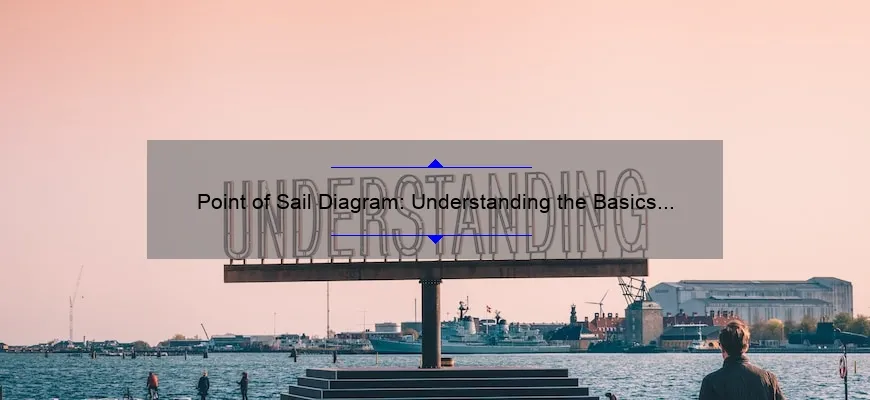
Short answer point of sail diagram: A point of sail diagram visually represents the different wind angles in relation to a sailing vessel’s direction. It illustrates direstions such as close-hauled, beam reach, broad reach, and running. This visual aid is useful for sailors to understand and navigate their boat based on wind conditions.
1) Understanding the Point of Sail Diagram: A Beginner’s Guide
Understanding the Point of Sail Diagram: A Beginner’s Guide
If you’re new to sailing or are preparing for your first sailing adventure, it’s crucial to have a solid grasp of the various points of sail. These points determine how a sailboat can navigate relative to the wind direction and play a vital role in understanding sail trim and optimizing boat performance. To help you master this fundamental concept, let’s delve into the point of sail diagram in detail.
The point of sail diagram is a graphical representation that illustrates the relationship between the wind direction and a boat’s course. It provides valuable information about where and how effectively a boat can travel according to the wind angle. Understanding this diagram will empower you as a sailor, enabling you to make informed decisions while out on the water and ultimately enhancing your overall experience.
At its core, the diagram consists of eight primary points or angles that define different sailing conditions. These locations are depicted in relation to two main positions:
1) Close Hauled: Starting at zero degrees, this is when boats are sailing directly into the wind. At this point, sails are typically trimmed tightly against the mast , allowing sailors to obtain maximum forward propulsion without drifting sideways due to excessive heel.
2) Running Dead Downwind: This position marks 180 degrees from close hauled and represents sailing with the wind coming directly from behind. In such cases, boats often assume their downwind running configuration by easing out their sails as much as possible.
Between these two extremes exist six additional points which are categorized into three sections – close reach (30-60 degrees off-wind), beam reach (90 degrees off-wind), and broad reach (120-150 degrees off-wind).
Starting from close hauled moving away from dead upwind or tacking direction: 3) Close Reach: Here, boats sail slightly offwind at an angle between 45-60 degrees from close hauled. Trimmed sails apply pressure, propelling the boat forward with a slight tilt away from the wind.
4) Beam Reach: At precisely 90 degrees off-wind from close hauled, sailors find themselves on a beam reach where the sails are set perpendicular to the direction of airflow. This position delivers optimal speed potential and stability .
5) Broad Reach: Moving further away from close hauled, the broad reach points encompass an angle range of 120-135 degrees off-wind. At this point, boats fall into an exhilarating downhill run as they angle their sails away from the centerline while maintaining control.
Continuing beyond dead downwind or jibing direction: 6) Running Dead Downwind (already mentioned above): Sailboats sail with the wind flowing directly behind them and tend to extend their sails out for maximum surface area. Skimming across waves in this position can be both thrilling and challenging to maintain balance due to shifting winds.
7) Broad Reach (opposite jibing direction): Similar to point number five but on the opposite side of dead downwind, sailboats continue sailing at angles between 120-150 degrees from close hauled. Here, they maintain controlled forward movement by adjusting their sails accordingly.
8) Beam Reach (opposite jibing direction): On the direct opposite side of beam reach lies this point where boats find themselves once again at a 90-degree angle off-wind. The same benefits of speed and stability apply here as well.
Now that we have dissected each point of sail comprehensively let’s explore why understanding this diagram is crucial for every sailor:
1. Sail Trim: Each point on the diagram corresponds to specific trim settings necessary for optimum performance. Understanding which adjustments are required under different conditions allows you to harness maximum power efficiently while minimizing drag through careful sail trimming.
2. Navigational Planning: By analyzing your destination relative to your current position and wind direction, you can choose which point of sail to adopt for efficient and comfortable sailing. This planning helps you anticipate potential challenges, such as areas with little wind or strong currents, which may require altering your course.
3. Safety: Knowing the points of sail diagram enhances your overall safety by providing insight into how your boat will behave under different conditions. It allows you to adapt and prepare for challenging situations, preventing accidents and ensuring a smooth and enjoyable ride.
4. Racing Tactics: If you’re into the competitive side of sailing, understanding the point of sail diagram can make a significant difference in attaining a winning edge. Properly exploiting wind angles during races allows you to gain speed advantages and position yourself strategically against fellow competitors.
In conclusion, comprehending the point of sail diagram is indispensable for every sailor, whether you’re a beginner exploring the waters or an experienced racer seeking excellence. By familiarizing yourself with the eight primary points on this graphical representation, you’ll master the art of achieving optimal performance while navigating various wind conditions. So chart your course confidently, trim those sails expertly, and set sail towards countless memorable adventures!
2) How to Interpret a Point of Sail Diagram: Step-by-Step Instructions
Title: Decoding the Point of Sail Diagram: A Masterclass in Navigation
Introduction: Navigating a vessel on the open seas can be both thrilling and daunting, especially for novice sailors. To minimize uncertainty and maximize safety, understanding a point of sail diagram is essential. In this blog post, we will unravel the mysteries behind interpreting a point of sail diagram through step-by-step instructions. So fasten your seatbelts, or rather, tighten those sails, as we embark on an exciting journey!
1. What is a Point of Sail Diagram? Before diving into decoding its intricacies, let’s establish what exactly a point of sail diagram represents. A point of sail diagram is a visual representation that showcases the direction and angle at which a sailing vessel can effectively navigate in relation to the wind.
2. Familiarize Yourself with Key Markers: When first encountering a point of sail diagram, it may seem like deciphering hieroglyphs. However, rest assured that these diagrams follow some common conventions:
a) Wind Direction Indicator: Typically depicted by arrows indicating wind flow towards the vessel from various points (e.g., N for north). This indicator sets the stage for orientation throughout the diagram interpretation process.
b) Craft’s Course Indicator: Often displayed as an arrow within the circle representing your boat-to-be navigated on water .
c) Points of Sail Guidelines: Here’s where it gets interesting! The chart will feature arcs or angular lines coming outwards from your boat’s course indicator arrow depicting different points of sail.
3. Understanding Points of Sail: Sailing vessels operate efficiently across eight key points defined by their relation to wind direction:
– Close-hauled (or Beating): If you notice lines inclined 30 degrees or less spanning out from your course indicator arrow towards upwind angles (-45o to +45o), you’ve found close-hauled positions showing effective sailing against the wind .
– Close reach: As the wind moves aft of your beam (90o to 45o), lines on your diagram will reveal an expanded fan shape, showcasing angular lines extending outwards as a gradual curve.
– Beam reach: Now you’re sailing perpendicular to the wind , with arcs gradually arching forward into a fully extended semi-circle.
– Broad reach: As we continue to shift further away from the wind (135o to 165o), the angles grow more obtuse. Here, you’ll observe sail positions appearing as straighter lines forming a gentle curve.
– Running before the wind: With winds coming directly from behind (180o), our course indicator arrow aligns itself at its highest point pointing forward. Lines on either side will extend straight out in a horizontal configuration reflecting smooth downwind sailing .
4. Identifying Optimal Angles: To optimize your boat’s speed and maneuverability at various points of sail:
– Pay close attention to how close-hauled angles form acute triangles with possible leeway. – Embrace optimal and comfortable angles on different reaches while ensuring sails maintain effective airflow. – Maintain control during broad-reaching stances by angling sails appropriately for balance and stability . – Master careful adjustments when running before the wind, preventing accidental jibes or uncontrolled gybes through thorough examination of sail orientation and position-related diagrams.
Conclusion: Once considered intricate hieroglyphs, point of sail diagrams now hold no secrets for us! You can confidently navigate any waterway using these step-by-step instructions. Understanding wind directions, fleetingly glancing at craft’s course indicators, and following the guidelines outlined in these diagrams allow sailors both novice and experienced to make informed choices maximizing efficiency and excitement on their nautical journeys! Happy sailing!
3) Frequently Asked Questions about Point of Sail Diagrams and their Importance
Introduction:
In the sailing world, point of sail diagrams are an invaluable tool used to understand and navigate different wind conditions. Whether you’re a beginner or an experienced sailor , having a clear understanding of these diagrams is crucial for efficient and safe sailing. In this blog post, we will address some frequently asked questions about point of sail diagrams and emphasize their importance in sailing.
1) What is a point of sail diagram?
A point of sail diagram is a graphical representation that illustrates the relationship between the direction of the wind and the course that a boat can sail relative to that wind. It categorizes various angles and positions at which a boat can sail with respect to wind direction, helping sailors determine the most effective route to their destination.
2) How does a point of sail diagram work?
A typical point of sail diagram consists of multiple arcs or sectors representing different directions relative to the wind. These sectors often include labels such as “upwind,” “reaching,” “beam reach,” “broad reach,” and “downwind.” By indicating the possible courses given specific wind angles, sailors can quickly identify which points they should aim for during their journey.
3) Why are point of sail diagrams important?
a) Safety: Understanding point of sail diagrams is essential for ensuring safety on the water. By knowing how to position your sails based on wind direction, you can prevent dangerous situations like accidental jibes (when the stern end crosses through the no-sail zone), which could result in injury or damage to your vessel.
b) Efficient navigation: Point of sail diagrams allow sailors to plot out alternative routes based on current wind conditions. By capitalizing on favorable winds, sailors can optimize their speed and efficiency during races or leisurely trips alike.
c) Sail trim adjustment: Different points on a boat require varying adjustments in its sails’ trim. Point of sail diagrams visually indicate these adjustments so that sailors can ensure proper tensioning depending on the wind angle. By achieving optimal sail trim, sailors can maximize their boat’s performance and speed.
d) Racing tactics: In competitive sailing, point of sail diagrams are indispensable tools for strategizing. These diagrams help racers analyze wind patterns and select the most advantageous course to take, allowing them to outmaneuver their opponents and gain a competitive edge.
4) Are there different types of point of sail diagrams?
Yes, there are various interpretations of point of sail diagrams, each tailored to specific sailing disciplines or regions. For instance, some diagrams include additional sectors like “close-hauled” or “power zone,” which provide more precise information about optimal angles in different conditions. However, regardless of the specific layout, all point of sail diagrams fundamentally serve the same purpose – visualizing the relationship between wind direction and boat maneuverability.
Conclusion:
Point of sail diagrams play an integral role in sailing navigation by providing sailors with a clear understanding of how to position their sails based on wind direction. They ensure safety on the water while simultaneously optimizing efficiency and speed during races or leisurely trips. By utilizing these graphical representations effectively, sailors can harness the power of wind and navigate with confidence towards their destination.
4) Exploring the Key Components of a Point of Sail Diagram
Exploring the Key Components of a Point of Sail Diagram
When it comes to sailing, understanding the different points of sail is crucial for any sailor. A point of sail diagram visually represents the various angles or directions a boat can travel relative to the wind. It acts as a compass on water, guiding sailors in making informed decisions about how to navigate their vessel effectively.
But what are the key components that make up a point of sail diagram? Let’s delve into each element and unravel their significance in navigating the vast seas .
1. Wind Direction Indicator: The first and foremost component of a point of sail diagram is the wind direction indicator. This arrow-like symbol represents the direction from which the wind is blowing. It serves as a reference point for determining the appropriate angle at which to set sails, helping sailors maximize their speed and control on a given course.
2. Boat Position: In any point of sail diagram, you will find a small representation symbolizing your boat or vessel. This icon allows you to carefully envision your boat’s orientation relative to both wind direction and other critical elements present on the diagram. By visualizing your boat’s position in relation to these elements, you can easily match it with one of the illustrated points of sail shown further in detail.
3. Points of Sail: Usually depicted by arcs or lines extending outward from your boat symbol, “points” represent specific sailing angles that correspond with optimal performance within each respective range on a point of sail diagram. The three primary points include:
– Close-hauled (or Upwind): This refers to sailing as close to an apparent headwind as possible while still maintaining forward momentum. On most diagrams, this angle is usually represented towards either side (port or starboard), showing where your boat should be positioned when heading upwind.
– Beam Reach: As implied by its name, this point lies perpendicular (90 degrees) to both close-hauled and broad reach. Sailors typically aim to sail on a beam reach when they’re sailing alongside the wind, allowing their sails to fill up and generate maximum power.
– Broad Reach: Widening the angle between your boat and the apparent wind, this point generally lies between beam reach and running. It’s considered an optimal position where boats can attain higher speeds while maintaining control due to favorable wind flow conditions.
Each of these points is vital for sailors as it provides them with clear directions on how to navigate their vessel effectively based on their desired course and the prevailing weather conditions .
4. Additional Elements: Some point of sail diagrams may include more elements depending on their complexity or purpose. These may include additional reference lines representing relative wind speed, labels indicating key sailing maneuvers, angles for tacking or gybing, and illustrations of sail trim positions for specific points of sail.
All in all, understanding each component within a point of sail diagram enables sailors to make informed decisions about how best to navigate their vessels. Leveraging this knowledge allows for optimized sailing performance by adapting to changing winds while maintaining control over one’s course.
So next time you find yourself out on the water with your trusty vessel, familiarize yourself with a reliable point of sail diagram. This indispensable tool will ensure that you maneuver through various angles efficiently, harnessing the wind’s power to propel you smoothly towards your destination. Happy sailing!
5) The Significance of Using a Point of Sail Diagram in Sailing Navigation
The art of sailing is a beautiful combination of skill, intuition, and knowledge. As sailors navigate the vast waters, they rely on various tools and techniques to ensure a safe and efficient journey. One such indispensable tool in their arsenal is the Point of Sail Diagram.
But what exactly is this diagram, and why is it significant in sailing navigation ? Let’s dive into the details.
In simplest terms, a Point of Sail Diagram visually illustrates the different positions a sailboat can be relative to the wind direction. By understanding these crucial points, sailors can determine the most favorable angles for setting their sails and optimize their speed and efficiency.
Why does this matter, you might wonder? Well, imagine you’re out on your boat, ready to embark on an exhilarating voyage. The wind blows briskly through your hair as you set off with high spirits. However, without proper guidance from a Point of Sail Diagram, you might find yourself struggling against the elements instead of harnessing their power!
Here’s where things get interesting – there are typically eight main points of sail depicted in these diagrams: close-hauled (or beating), close reach (or close reach), beam reach, broad reach (or broad reach), running (or downwind run). These names might sound peculiar at first glance but fear not; we’ll unravel their meaning soon enough.
Close-Hauled: Picture yourself navigating directly upwind; this position allows you to sail as closely into the wind as possible. With sails trimmed tight and skillful maneuvering at play, you’re making progress against all odds – an exciting challenge that truly tests your sailing prowess!
Close Reach: Now envision adjusting your course slightly away from directly upwind – this point boasts more favorable conditions as it grants greater maneuverability while still benefiting from winds coming predominantly from ahead.
Beam Reach: Ah! This is where things start getting intriguing! At this point of sail, imagine sailing perpendicular to the wind direction, with the gusts silky-smoothly brushing against the side of your vessel. A true sailor’s delight!
Broad Reach: Now we’re talking! Taking a gradual turn away from the wind, you’re presented with even more favorable conditions. Your sails are now filled with a gentle breeze coming at an angle from behind your back, propelling you forward with grace and finesse.
Running: Ahoy there, matey! This is where the magic happens! As you navigate directly downwind and embrace the full power of the wind pushing you along, exhilaration takes over. The sails billow out before you like wings in flight, and your boat glides effortlessly through the water – a symphony of speed and agility!
Understanding these various points enables sailors to employ smart strategies when plotting their course or adjusting sail angles on their vessel, ensuring they’re always poised to take advantage of prevailing winds.
Using a Point of Sail Diagram in sailing navigation is not just about optimizing speed; it’s also crucial for safety reasons. By analyzing this diagram in conjunction with other vital factors such as weather conditions and potential hazards along your route, you can make informed decisions that keep you and your crew out of harm’s way.
It’s important to mention that while these diagrams serve as valuable aids for sailors, they should not be solely relied upon without considering real-time observations and intuition. Mother Nature can surprise us at times, so being flexible and adaptable is just as essential as having a solid understanding of sailing principles.
In conclusion, a Point of Sail Diagram holds immense significance in sailing navigation by offering an all-encompassing visual representation of sail positions relative to wind direction. With its guidance, sailors can confidently harness nature’s forces to propel them toward their destination swiftly and safely – all while indulging in the thrill that only sailing can provide. So next time you set sail on waters unknown with dreams of adventure dancing in your heart, remember to consult your trusty Point of Sail Diagram, and let the winds carry you to places you’ve only dared to imagine!
6) Mastering Sailing Techniques through Point of Sail Diagrams
Sailing, the age-old practice of harnessing the power of wind to navigate through water, has captivated adventurers and seafarers for centuries. It offers a sense of exhilaration and freedom that is hard to find in any other activity. However, mastering the art of sailing can be quite a challenging endeavor, as it requires a deep understanding of various sailing techniques.
One effective way to demystify these techniques is by utilizing point of sail diagrams. These ingenious visual aids provide sailors with a comprehensive overview of how different angles to the wind can affect their sailboat’s performance and maneuverability. Whether you’re an experienced sailor looking to brush up on your skills or a budding enthusiast eager to learn the ropes, point of sail diagrams are your secret weapon!
Let’s dive into why these diagrams are crucial in mastering sailing techniques. Imagine yourself gliding across the open waters, feeling the wind rush through your hair and the sun kissing your skin. But suddenly, you find yourself struggling to steer your boat in a straight line or make efficient turns. Frustrating, isn’t it?
This is where point of sail diagrams come into play – they serve as invaluable roadmaps for navigating different wind conditions effectively. Each diagram depicts various angles to the wind relative to your boat’s position and helps you understand how these angles impact your sails’ trim settings .
For instance, if you’re sailing directly downwind with the wind blowing from behind (known as “running” or being on a “downwind” course), point of sail diagrams will show you how certain adjustments like easing out sails or employing special downwind techniques can enhance your speed without compromising stability.
On another note, say you’re navigating upwind against the direction where the wind is coming from (“beating” or being on an “upwind” course). Point of sail diagrams become even more vital here! They enable you to identify optimal angles known as “close-hauled,” “close reach,” or “beam reach,” where your sails can efficiently capture the wind ‘s force and propel your vessel forward with maximum speed.
Furthermore, these diagrams also help you grasp the concept of the “no-sail zone” or “irons.” This refers to a range of angles where the wind hits your boat head-on and stalls any forward movement. By understanding this critical no-sail zone and staying clear of it, you’ll avoid frustrating situations where you’re stuck in place, unable to make any headway against the wind.
Now that we’ve established how point of sail diagrams enhance your sailing knowledge, let’s explore how they can be leveraged in a witty and clever manner. Sailing is often associated with a sense of adventure and freedom, so why not approach learning its techniques with some lighthearted fun?
Imagine a point of sail diagram featuring cheeky illustrations of seafaring creatures – from crafty dolphins to wise old sea turtles – navigating through various angles to the wind. This whimsical touch adds an element of playfulness while still delivering functional information about sailing techniques .
Another way to infuse wit into such diagrams could involve using quirky captions. For example, a diagram illustrating sailing upwind might feature a drawing of a determined sailor accompanied by the caption: “Conquering adversity like a salty sea dog!” These amusing captions create relatable scenarios that resonate with sailors at all levels, making them more likely to remember and apply the techniques depicted.
In conclusion, mastering sailing techniques can be effectively achieved through point of sail diagrams. These visual aids offer detailed insights into how different angles to the wind affect your sailboat ‘s performance. By studying these diagrams attentively and employing some clever design choices like playful illustrations or humorous captions, sailors will find themselves on their way to becoming seasoned masters of the sea ! So grab your compasses and charts; it’s time for an unforgettable seafaring adventure!
Recent Posts

- Sailboat Gear and Equipment
- Sailboat Lifestyle
- Sailboat Maintenance
- Sailboat Racing
- Sailboat Tips and Tricks
- Sailboat Types
- Sailing Adventures
- Sailing Destinations
- Sailing Safety
- Sailing Techniques
Nottingham Forest docked four points for breach of Premier League rules
The commission said Forest took a risk by effectively ignoring the danger before the January 2023 transfer window, adding players rather than selling them, and knew it was "sailing close to the wind", meaning the league had to issue an appropriate punishment.
Monday 18 March 2024 19:12, UK

Nottingham Forest have been docked four points for a breach of the Premier League's rules on profitability and sustainability.
The deduction puts the team in the relegation zone, in eighteenth place, one point from safety with nine games to go, having narrowly avoided the drop last year.
Forest were charged in January after confirming they were in breach of the rules for the assessment period ending 2022-23.

The six-point deduction Everton received for similar breaches - reduced from 10 on appeal - is regarded by some as a benchmark punishment. Everton also face a second charge which has not yet been adjudicated on.
Forest said they are "extremely disappointed" with the decision, which "raises issues of concern for all aspirant clubs".
"We were extremely dismayed by the tone and content of the Premier League's submissions before the commission," a club statement read.
"After months of engagement with the Premier League, and exceptional cooperation throughout, this was unexpected and has harmed the trust and confidence we had in the Premier League."
More from UK

Money blog: Bank of England voting hints change is coming as rate held at 5.25% - savers urged to act now

Women affected by change in state pension age 'are owed compensation', report finds

Sarm Heslop: Mother of British woman missing in US Virgin Islands asks President Biden for help finding her daughter
A statement from the Premier League said: "Nottingham Forest was referred to an independent commission on 15 January, following an admission by the club that it had breached the relevant PSR threshold of £61m by £34.5m.
New Premier League rules
"The threshold was lower than £105m as the club spent two seasons of the assessment period in the EFL Championship.
"The case was heard in accordance with new Premier League Rules, which provide an expedited timetable for PSR cases to be resolved in the same season the complaint is issued.
"The independent commission determined the sanction following a two-day hearing this month, at which the club had the opportunity to detail a range of mitigating factors.
"The commission found that the club had demonstrated "exceptional cooperation" in its dealings with the Premier League throughout the process."
The ruling shows the Premier League pushed for a six-point sanction - with eight points as an initial figure to account for Forest's excess over the threshold being 77% greater than Everton's, but discounted by two points to reflect Forest's early plea and co-operation.
Forest argued that any points deduction should be "minimal", because they turned down several lower offers for striker Brennan Johnson last summer, before eventually accepting a bid of £47m from Tottenham, meaning their PSR breach was a "near miss".
'Sailing close to the wind'
With all the money earned from selling Johnson, an academy product, going down as a profit, the club argued their approach was designed to make them more sustainable, but the commissioners did not accept this reasoning.
It said in its ruling: "When a club like Forest took the risk of effectively ignoring the PSR warning from its finance director before the January window in 2023, and rather than looking to sell players, it added players to its squad, ultimately leaving itself with just two weeks to sell Player A (Brennan Johnson) in the summer 2023 window, such risk-taking and 'sailing close to the wind' needs a proportionate sanction to maintain the integrity of the Premier League."
Read more: Everton saga 'shows league can't regulate football' PL scrambles to secure £836m New Deal British South Asian referees PL game for first time
Calling the breach "serious", the commission said in its conclusion the sanction was not meant to punish Forest "so much as it is to be fair to the other clubs; to give the public confidence that when a club invests as Forest did to compete in the Premier League, it still needs to comply with the PSR threshold for losses."
The club have yet to say whether or not they would appeal.
Under the 'standard directions' for dealing with PSR complaints, any appeal outcome must be known prior to 1 June, when promoted clubs receive their Premier League 'shares', which effectively confirms their place in the league.
The punishment comes two days after Forest were held to a 1-1 draw by fellow strugglers Luton Town, who scored a late equaliser.

IMAGES
VIDEO
COMMENTS
The points of sail include into the wind (in irons), close hauled, close reach, beam reach, broad reach, and running, which go from windward to leeward and are all symmetric from port to starboard. Knowing the points of sail on a sailboat is important in terms of being knowledgeable about how your sailboat generates wind power while also being ...
The close reach is the point of sail between close hauled (about 45 degrees) and beam reaching at 90 degrees off the wind. If you're sailing hard upwind on a beat, and you ease the sails and point the boat a bit off the wind, you are close reaching. The wind is still forward of the boat, so you're making upwind progress on a close reach.
The Points of Sail describe the range of courses a sailboat can and cannot travel. Understanding the Points of Sail. It is physically impossible for a boat to sail directly into the wind but how do you describe that? This "no-sail" zone is approximately a 90-degree zone dead into the direction of the wind. While this zone varies in size ...
The points of sail are the course directions that a sailing vessel can take with respect to the wind direction. These include: In Irons (directly into the wind), Close-Hauled (as close to the wind as possible while still moving forward), Close Reach (between close-hauled and beam reach), Beam Reach (wind coming directly from the side), Broad Reach (wind coming from behind at an angle), and ...
The 5 points of sail describe the angles a sailboat can sail relative to the wind direction, and we have a name for each of them: Close-hauled: Sailing close to the wind. Close reach: Bearing away from the wind. Beam reach: The wind comes from the side. Broad reach: Sailing away from the wind.
The points of sail. The recognized points of sail are judged relative to the true wind direction. They include: Into the wind where a sailing craft is pointed directly upwind in the middle of the no-go zone, where sails cannot generate power.; Close-hauled where a craft is sailing, pointed near the no-go zone.; Reaching, including: . Close reach: between close-hauled and a beam reach.
The sailboat's orientation during this point of sail evokes a sense of descending down a slope. The serenity of the wind's speed, coupled with the reliable forward movement, makes the broad reach a personal favorite among many sailors. 6. Running. Our final point of sail brings us to the running point—a sailboat's true downwind trajectory.
A close reach is the point of sail where your boat is sailing at an angle between close-hauled and a beam reach, typically around 60 degrees off the wind direction. This point of sail offers a balance between speed and the ability to sail upwind, making it a popular choice for cruising and racing sailors alike.
Points of Sail Overview. The Points of Sail refer to the different angles of sailboat travel relative to the wind. There are five main points of sail: Close Hauled, Beam Reach, Broad Reach, Running Downwind, and No-Sail Zone. Each point of sail has its own set of characteristics and requires different sail trim and steering techniques.
No-Sail Zone. This is the point directly upwind of the Sailboat. The Sails cannot generate power since the boat is pointed too close to the Wind. When the Wind is coming from where you want to go, you will be forced to follow a zigzag course. The Sail will be flapping like a flag. The closest you can get is 40-45º of the direction of the Wind.
A points of sailing diagram is a visual representation illustrating different angles and directions a sailboat can sail relative to the wind. It helps sailors understand optimal angles for sailing upwind (close hauled), reaching (beam reach), and downwind (running) positions.
Short answer point of sail: The term "point of sail" refers to the direction a sailboat is sailing relative to the wind. There are eight main points of sail, including upwind, close-hauled, beam reach, broad reach, running, and others in between. Each point of sail requires different adjustments to optimize boat speed and maneuverability.
==Short answer points of sailing:== Points of sailing refer to the different angles at which a sailboat can navigate relative to the wind. There are close-hauled, beam reach, broad reach, and downwind points. These terms help sailors understand how to position their sails effectively for optimal speed and maneuverability. The Basics: Understanding the Points of
Head to Wind: 0 - 30 degrees off the wind. Full stop or moving backwards. Worst possible point of sail. Beating: 40 - 45 degrees off the wind. Very likely to be slightly heeled and both crew and helm leaning out of the boat. All sails tightly in. Close Hauled: 45 degrees off the wind. Slightly faster than beating.
This point of sail lies about 45 degrees off the wind. Being close-hauled is also referred to as beating into the wind or simply "beating.". When you are close hauled, you are very aware of the strength of the wind. Waves are more impactful and may be hitting the boat and make for a wet ride.
Beam Reach (Sailing Crosswind) - In this zone you are sailing at a 45-degree angle to the wind. When the wind is blowing across the boat, you are reaching. This is usually the fastest and the most comfortable points of sail. Broad Reach (Sailing Downwind) - At this angle you are sailing downwind as close as you can without running directly ...
This is a precise point of sail and is exactly perpendicular (or 90°) to the direction of the wind, from the direction of the wind. Here the sails are let out half way and the centreboard on sailing dinghies is set to ½ down. Generally for most boats this is an efficient point of sail and can provide for the fastest speeds. Broad Reach.
Close-hauled is the point of sail closest to the wind. Sailors set their sails at a tight angle to catch the wind effectively. To sail close-hauled, position your sailboat at an angle of 30-45 degrees to the wind direction. The angle of the no-sail zone (ability to sail closest to the wind) varies for different boats.
Beam reach: This is the fastest and easiest point of sail. The wind will be on the side of your boat (beam) and you'll sail with your sails out halfway. Broad reach: On a broad reach you'll be heading a bit further downwind, so you'll have to let your sails out a bit more. Training run: Here, the wind will be slightly to one side of your ...
The main points of sail are: Close-hauled: Sailing as closely as possible into the wind. This requires the sails to be trimmed in tightly, and the boat moves forward at an angle against the wind. Close reach: Sailing diagonally to the wind, between close-hauled and a beam reach. Beam reach: Sailing perpendicular to the wind.
3. Hone your skills in different points of sail: Learn to navigate effectively at various angles to the wind, mastering the art of sailing in all directions. 4. Enhance your boat handling abilities: Develop the expertise to control the boat proficiently in different weather and water conditions. 5.
Sailboats: Monohulls can heel (lean) while sailing, which some sailors enjoy for the thrill but can be discomforting for others. Catamarans: Greater stability due to the dual hulls, providing a ...
Mastering Sailboat Navigation: Unveiling the Power of the Points of Sail Diagram. Sailboat navigation is an ancient art that mariners have entrusted their lives to for centuries. From early explorers to modern-day sailors, understanding the ins and outs of navigating a sailboat is crucial for a successful voyage. One powerful tool that has ...
The ship is scheduled for delivery in 2025 as part of a multi-year expansion of the Disney Cruise Line fleet that includes the Disney Wish and Disney Treasure, the Disney Adventure that will homeport in Singapore, and the new island destination in The Bahamas, Disney Lookout Cay at Lighthouse Point.
The Germany-based company operates three large sailing ships where the sails are unfurled by hand, just as they were on sailing ships centuries ago. On the biggest of these three vessels, the 136-passenger Sea Cloud Spirit , 18 deckhands scurry high into the rigging on sea days to manually untie and prepare the sails, an amazing sight.
2. Best for families: Croatia. The calm, clear waters of the Adriatic combined with favourable weather conditions in summer provide easy sailing for families and, with more than 1,000 islands ...
A point of sail diagram is a visual representation that showcases the direction and angle at which a sailing vessel can effectively navigate in relation to the wind. 2. Familiarize Yourself with Key Markers: When first encountering a point of sail diagram, it may seem like deciphering hieroglyphs.
The commission said Forest took a risk by effectively ignoring the danger before the January 2023 transfer window, adding players rather than selling them, and knew it was "sailing close to the ...